Can a luxury charter yacht survive rough seas?
- Inspiration

Related News
Popular news this week, popular news this month, latest news.
- Yacht Charter & Superyacht News >
Written by Rachael Steele
When it comes to someone’s first holiday on the water, one of the questions that might be racing through his or her mind is: ‘Can the luxury charter yacht survive rough seas’?
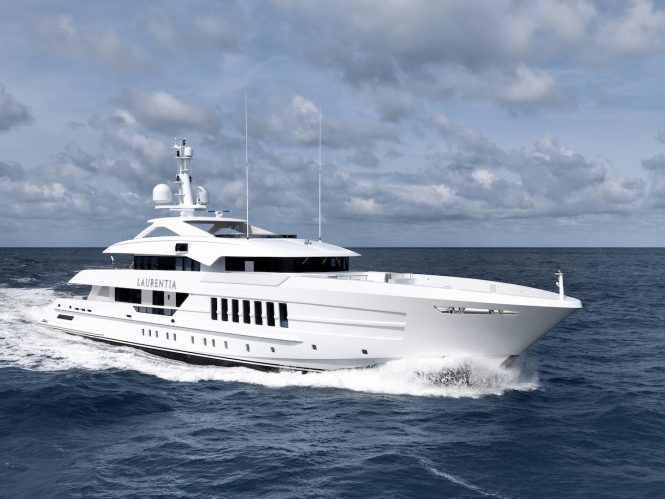
Charter yacht Laurentia
The short answer is ‘yes’, however, this might not reassure the underlying concern of what it takes to damage a vessel to such an extent that the crew and guests are in danger, and a more in-depth look at the situation is required.
Different vessels have different methods other than ballast for ensuring stability in the water: Sailing yachts have keels while motor yachts have stabilisers that reduce the pitch and roll while at anchor (known as ‘zero speed stabilisers’), and some versions can be used even while cruising. Expedition yachts are even expected to encounter rough seas on journeys to remote destinations and are equipped accordingly.
Catamarans and trimarans will have even greater stability, and these vessels are a popular choice for cruising in the Caribbean and Bahamas, where the shallow draft grants access to tranquil anchorages close to the shores.
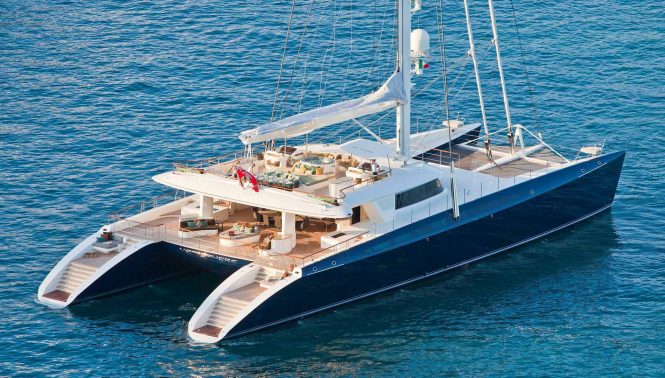
Luxury charter catamaran Hemisphere
During the construction of each unique hull design, naval architects and engineers undertake tank tests to ensure the seaworthiness of the vessel. The Douglas Sea Scale defines ‘rough seas’ as 2.5-4m/4.1-8.2ft with very rough conditions being 4-6m/13-20ft.
At Southampton University tank tests showed that when a wave was 30% as high as the hull length, it was possible to capsize some yachts. However a wave as high as 60% of the hull length capsized all vessels. So the size of a vessel also plays a role in its stability and safety on the water.
For example, to cause danger to a motor yacht of 30m/98ft, a wave must be at least 9m/29ft and as high or higher than 18m/58.8ft to sink the vessel – these wave sizes correlate to the Very High and Phenomenal categories at the top of the Douglas Sea Scale and are unlikely to be encountered unless in hurricane conditions. Under these circumstances, you’d be much happier aboard your sailing yacht or motor yacht than one of the fishing boats in the Cyclades harbours!
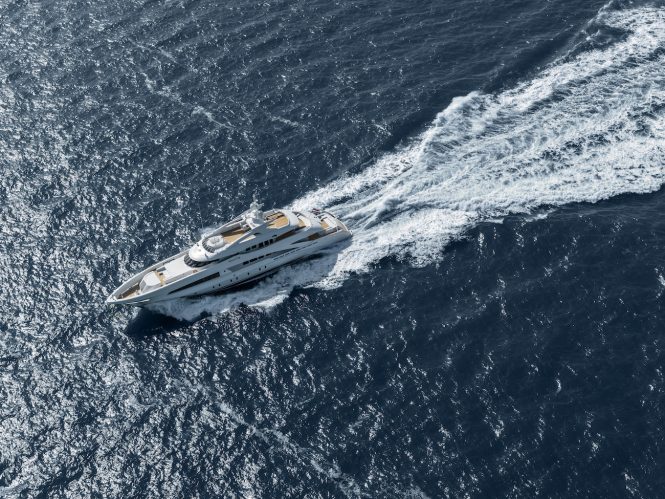
Modern yachts are designed to survive rough seas
However, it is unlikely that you will encounter such conditions during your luxury yacht charter: The Captain receives a daily weather report and will be aware of nearby ports and other sheltered anchorages to wait out the storm, and your professional crew will ensure the safety of everyone on board. Although rough to very rough conditions will make life on board unpleasant for guests and crew alike, both sailing yachts and motor yachts are prepared for such weather.
CONTACT CHARTERWORLD TO ASK ANY QUESTIONS ABOUT A PRIVATE YACHT CHARTER
Please contact CharterWorld - the luxury yacht charter specialist - for more on superyacht news item "Can a luxury charter yacht survive rough seas?".
- Charity & Fund Raising
- CharterWorld News
- Classic Yachts
- Coronavirus
- Cruise Ship
- Ecological Yachts
- Expedition Yachts
- Expert Broker Advice
- Feature Superyachts
- Interior Design
- Legal & VAT Yacht Issues
- Luxury Catamarans
- Luxury Gulet
- Luxury Phinisi
- Luxury Trimarans
- Luxury Yacht Design
- Luxury Yachts
- Marinas & Harbours
- Marine Ecology
- Marine Electronics
- Marine Equipment
- Mega Yachts
- Modern Yachts
- Motor Yachts
- New Launch Yachts
- New To Charter
- Open Style Sports Yachts
- Private Jets
- Sailing Yachts
- Social Media
- Sports Yachts
- Superyacht Crew
- Superyacht Photographers
- Superyacht Products & Supplies
- Superyacht Refits
- Superyacht Reviews
- Superyachts
- Uncategorized
- Yacht Builders
- Yacht Charter
- Yacht Charter Destinations
- Yacht Charter Picks
- Yacht Charter Specials
- Yacht Delivered to Owner
- Yacht Designers
- Yacht Events & Boat Shows
- Yacht Fashion
- Yacht Industry News
- Yacht Photos
- Yacht Racing
- Yacht Racing & Regattas
- Yacht Safety Equipment
- Yacht Support Vessels
- Yacht Tenders
- Yacht Videos
- Yachting Associations
- Yachting Awards
- Yachting Business
- Yachts For Charter
- Yachts For Sale
Quick Enquiry
Superyacht news:.
Email Your Yachting News to: news @ charterworld.com
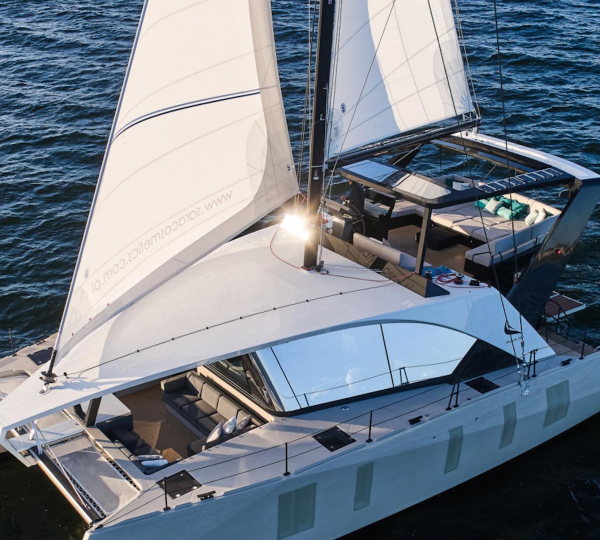
The Caribbean

New Luxury Crewed Yachts Available for Charter
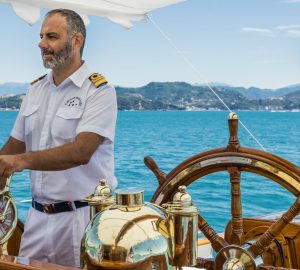
Top 10 charter yachts with classic interior
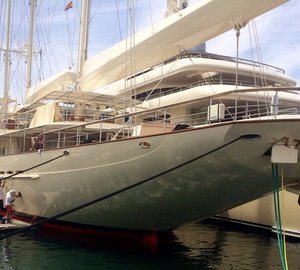
Outstanding 90m Mega Yacht ATHENA coated by Zytexx
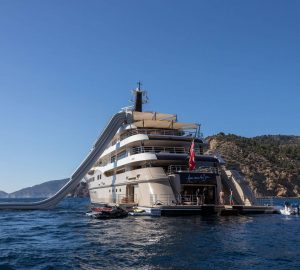
Top 10 most luxurious charter yachts from 2017
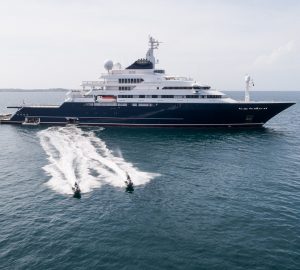
10 sensational superyachts with spectacular swimming pools
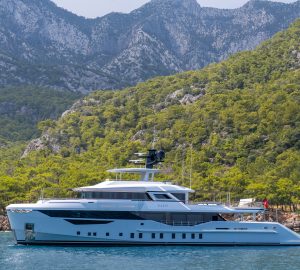
Superyacht KAŞIF on route to the 2024 Cannes and Monaco Yacht Shows
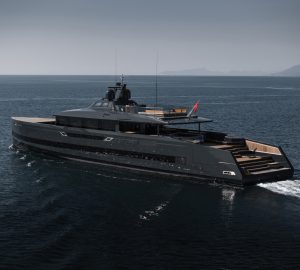
45m custom superyacht SAN will debut at the 2024 Monaco Yacht Show
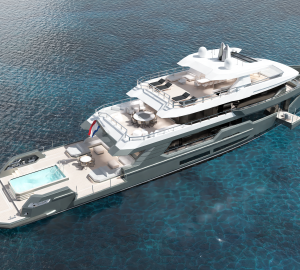
Leapher Yachts unveils 49m luxury explorer yacht NAVIX50
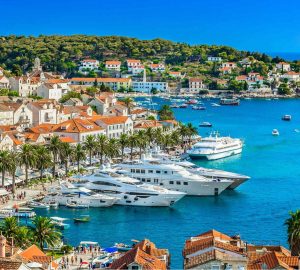
Inaugural CROYA Charter Show announced for 4th to 6th October 2024 in Split, Croatia
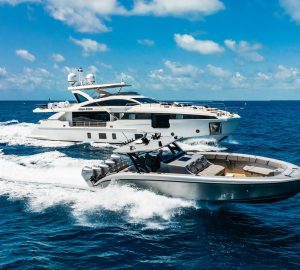
31m luxury yacht CARPE DIEM available for charter in the Bahamas

OCEA delivers 33m motor yacht ARAOK II to her new owner
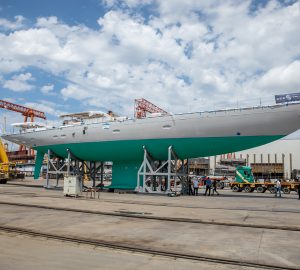
39m sailing yacht LINNEA AURORA launched by SES Yachts
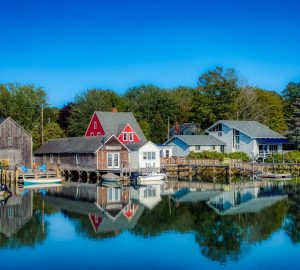
A luxury charter yacht is the perfect way to encounter New England’s fall foliage display
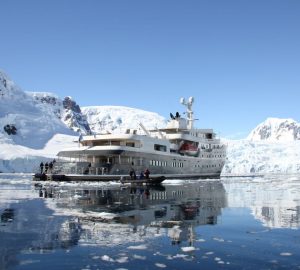
Charter yachts offering citizen science opportunities around the world
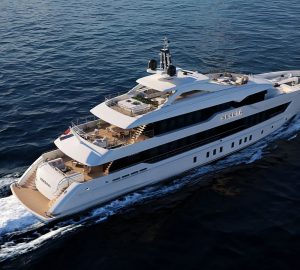
55m superyacht YN20555 is launched by Heesen Yachts and named superyacht SERENA
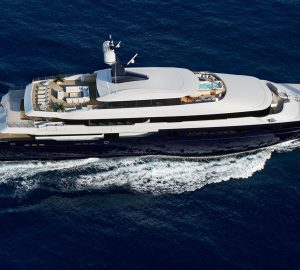
Late summer special offer on board 72m superyacht ARBEMA in the Western Mediterranean
American billionaire and owner of Harbor Freight stores just took delivery of this 384-feet long megayacht. The $350 million vessel has seven decks, a pool, and a yoga studio it uses AI to stabilize the mammoth yacht on rough seas.
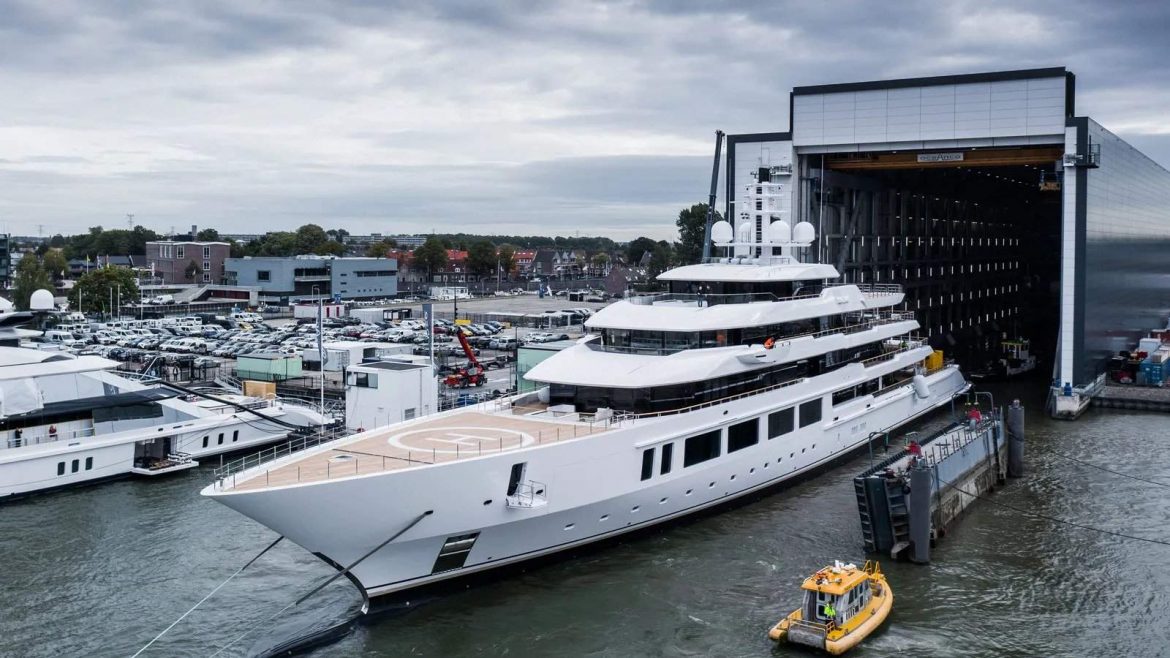
You may also like
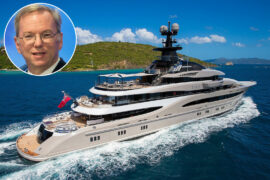
Ex-Google CEO Eric Schmidt raised millions for a children’s charity by donating his $156 million Whisper superyacht for a seven-night voyage. The kind-hearted billionaire has also included fine wine worth thousands for the six couples that will cruise the Mediterranean on his 312′ vessel.
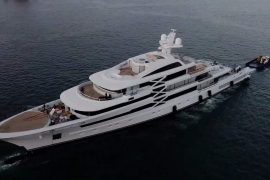
Not Italian or German but a Greek shipyard has unveiled this 289 feet long superyacht. Project X by Golden Yachts has one of the largest glass elevators ever installed on a vessel, it comes with a Hammam and Finnish sauna, a massive gym, and a glass-walled pool.

A mystery Saudi billionaire’s nearly completed $250 million superyacht was burnt to scrap in a devastating fire that engulfed a Lurssen shipyard in Germany.
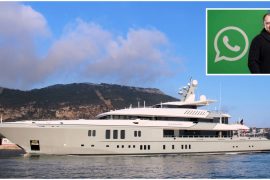
Take a look at WhatsApp founder Jan Koum’s second and more modest $75 million superyacht Mogambo – The 241 feet long vessel of the rags to riches billionaire has a sky lounge with a massive 3D television, a beach club and a range of water toys
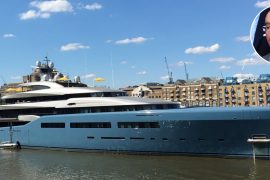
Take a look at Joe Lewis’s stunning $250 million superyacht, Aviva, which the Tottenham owner used to bail himself out of trouble. The billionaire loved padel tennis so much that he actually built this 279 feet long vessel around a padel tennis court.

This Florida billionaire commissioned Vacheron Constantin to create the world’s most complicated watch. With 63 different complications, 2,877 parts, and 31 hands, it took the watchmaker a year just to assemble the multi million dollar timepiece.
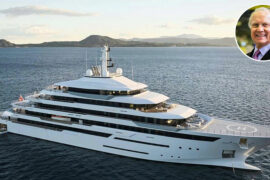
Take a look at the 367-foot superyacht ‘Renaissance’ owned by Gary Klesch. Once earning less than $10,000 a year, he now owns this $200 million vessel. It features an entire deck dedicated to wellness, a cinema, a massive swimming pool, and even a sushi bar.

In spite of a massive $5 million discount, the world’s shiniest superyacht is not finding any buyers
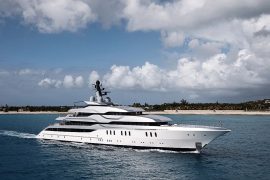
Its been more than a year since the FBI raided and seized Russian billionaire’s $90 million superyacht in Spain, but the United States is still paying the sky-high maintenance bills for its upkeep – Docked at an exclusive marina the parking charges for the vessel alone are $200,000.
- Yachts for Sale
- Sales Report 2024
- FAQ – Luxury Crewed Yacht Charters
- FAQ – Bareboat charters
- FAQ – Sell your Boat
- FAQ – Buying a Yacht
- How Much does it Cost to Charter a Luxury Yacht?
- All Blog Posts and News
- Yachting for beginners
- Indian Ocean
- Mediterranean
- Sales & New build
- Motor Yacht
- Event & News

How is a Luxury Yacht doing in Rough Seas?
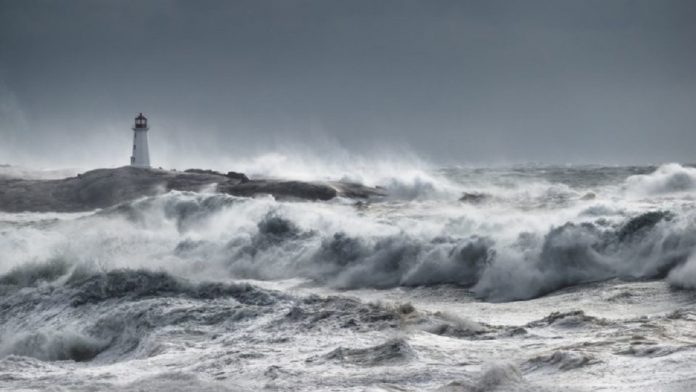
Luxury yachts are the ultimate symbol of indulgence in the world of boating. With their sleek designs, high-tech features and luxurious interiors, these vessels are ideal for those who want to experience the opulence of life at sea. However, when it comes to facing harsh weather conditions, even the most expensive yachts can be tested to their limits. The question is, how well do these luxury yachts perform in rough seas?
What can we call rough sea conditions?
Rough sea conditions refer to the state of the sea characterized by high waves, strong winds, and heavy swells. These conditions are common during storms or extreme weather events, making sailing or boating more challenging and dangerous. The height of waves during rough sea conditions can exceed 3 meters, which can cause vessels to pitch and roll, affecting the stability and safety of the crew and the yacht. Additionally, rough sea conditions can also cause high levels of water spray, making visibility difficult and reducing the effectiveness of navigation aids.
Should you expect to have rough conditions during a yacht charter?
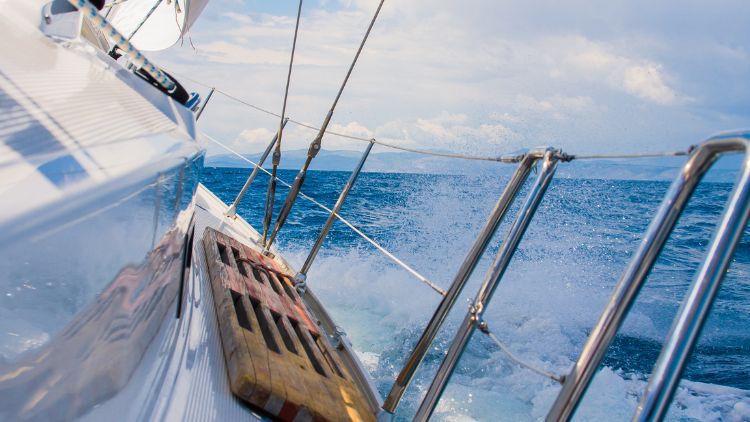
Trimarans are often considered to be some of the best performers in rough waters due to their design features. Their three-hull structure provides increased stability, reducing the rolling motion that can cause seasickness and discomfort. Additionally, the wider beam of trimarans gives them more surface area on the water, improving their stability further. Another benefit of trimarans is their ability to maintain speed in rough seas. The aerodynamic design of their hulls, coupled with the increased stability, allows them to cut through choppy waters while maintaining a relatively smooth ride.
Read also: The Caribbean To Mediterranean Sailing Routes: How To Cross The Atlantic Eastward
Most sailing yachts are resistant in difficult weather conditions
When it comes to sailing yachts, some types are better equipped to handle rough seas than others. One such type is the ocean cruiser, which is designed specifically for long-distance sailing in all conditions. Ocean cruisers typically have a heavier displacement, a deep keel, and a strong hull, which helps them to maintain stability and ride out storms. Another type that excels in rough seas is the bluewater cruiser, which is also designed for offshore sailing. These yachts feature a high freeboard, which keeps the cockpit and cabin drier in heavy seas, and a keel that is deep enough to provide good stability. Other types of yachts, such as performance cruisers or racing yachts, may not be as well-suited for rough seas, as their focus is on speed rather than durability in challenging conditions. It’s worth noting, however, that even the most seaworthy yacht can be overwhelmed in extreme weather, so it’s always important to exercise caution and good judgement when sailing in rough seas.
Motoryachts, especially superyachts and megayachts handle rough sea really well
When it comes to handling rough seas, luxury motor yachts come to the forefront with their exceptional seaworthiness and stability. Superyachts and megayachts, with their larger size and weight, offer a smoother ride in choppy waters. The deep-V hull design found in these larger yachts helps them cut through the waves with ease, reducing the impact of a rough sea. Additionally, these boats often feature advanced technology and stabilisation systems that further minimise uncomfortable motion.
Which types of yachts are the most uncomfortable in rough conditions?
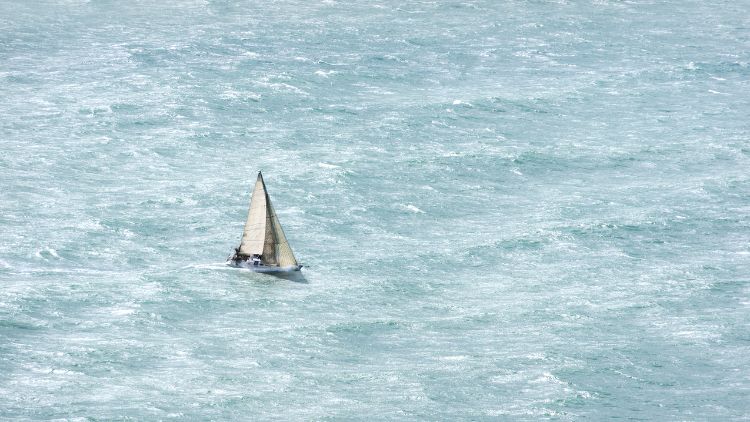
Catamarans are notoriously uncomfortable once the sea is getting too wild
When it comes to yachts and rough conditions, certain types are more prone to discomfort than others. Catamarans, for example, are often cited as being particularly uncomfortable during rough seas. This is due to their design – catamarans feature two parallel hulls that sit above the water. While this design can provide increased stability in calmer waters, it can pose problems when the sea gets choppy. Because the hulls are separate, rather than being connected like a traditional single-hulled yacht, the boat can bounce around more, leading to a rougher ride. Of course, the severity of discomfort will depend on a variety of factors, including the size of the catamaran, the strength of the waves, and the experience of the captain. However, if you know you’re headed into rough waters, it’s worth bearing in mind that a catamaran may not be the most comfortable option.
Monohulls will tilt drastically in bad weather conditions
Monohull yachts are generally considered the most uncomfortable in rough weather conditions. This is because monohulls are more susceptible to tilting or heeling dramatically when the waves become choppy, leading to a much more unstable and uncomfortable ride for those on board. In some cases, the boat may even list to one side or the other, causing occupants to struggle to maintain balance and potentially leading to seasickness. In contrast, multihull yachts such as catamarans are generally considered more stable and comfortable in rough conditions, as their wider hulls and lower center of gravity help them to better withstand the effects of wind and waves..
Read also: Best yachts for transatlantic: our selection and advices
What does it feel like to be in a yacht while the sea is rough?
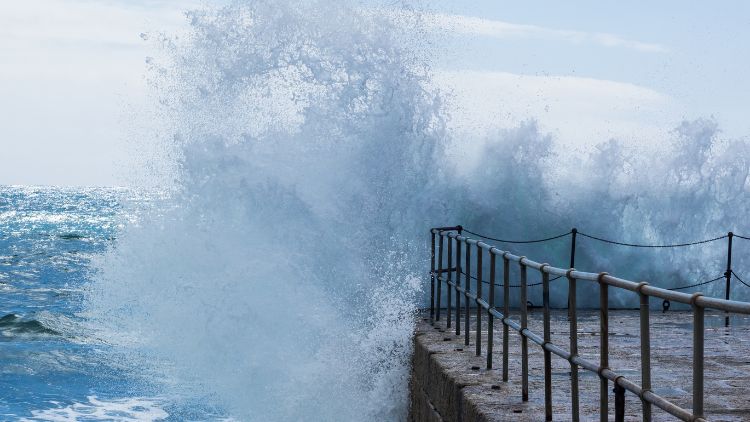
Try now - Live tracking map for yachts and other vessels
Real time world map for tracking yachts and all other vessels like speed boats, cargo or tankers! Tracking yachts and other vessels was never so easy!
Lightning Superyacht: A Masterpiece of Elegance and Luxury
Setting sail on a dream.
Imagine a world where your dreams unfurl on the open ocean, where the sun-kissed waves beckon, and the scent of adventure fills the air. Now, picture yourself stepping aboard the Lightning superyacht by Lurssen , a vessel that transcends the boundaries of luxury. It’s not just a yacht; it’s the embodiment of opulence and sophistication on the water. Buckle up as we embark on a journey through the world of mega yachts, exploring every facet of the Lightning experience.
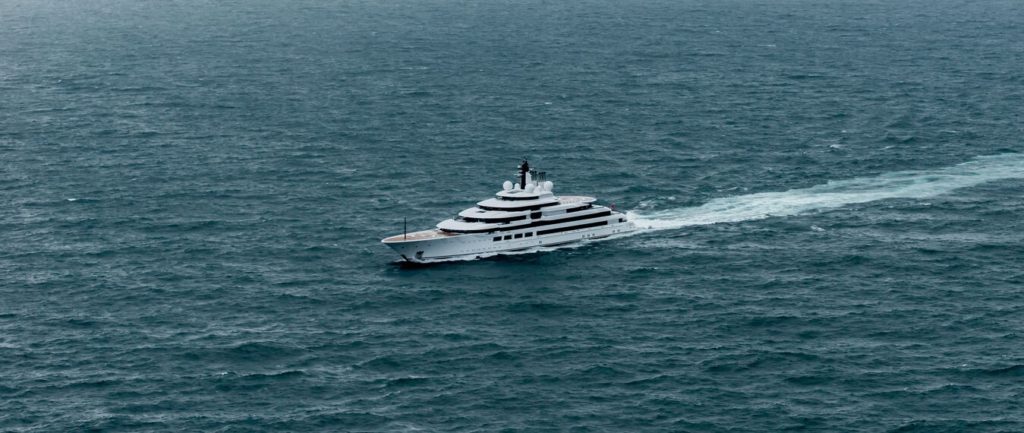
The Lürssen Legacy
Lurssen , a name etched in maritime history, stands as a testament to craftsmanship, innovation, and enduring quality. For over a century, this German shipyard has been the driving force behind luxury yacht construction, dating back to its establishment in 1875. The Lightning yacht is but one jewel in the crown of this shipyard’s prestigious legacy, a legacy that continues to redefine elegance and sophistication on the high seas.
Unveiling the Lightning Superyacht
Prepare to be awe-struck as we stand before the Lightning, a colossal mega yacht that stretches an astonishing 140 meters in length. To put it in perspective, this superyacht effortlessly dwarfs the average luxury yacht. Every inch of its design has been meticulously crafted with relentless attention to detail. The Lightning yacht boasts a timeless exterior that marries classic and contemporary elements seamlessly, creating a visual masterpiece that commands attention in every port of call.
Luxurious Living Aboard Lightning Superyacht
Stepping inside the Lightning is like entering a realm where lavishness knows no bounds. It’s a world where every corner mirrors the opulence of the finest luxury hotels and estates. From the lavishly appointed lounges to the sumptuous cabins, this is not merely a yacht; it’s a floating palace designed exclusively for those who demand nothing but the absolute best.
Cutting-Edge Technology
While opulence and elegance define the Lightning’s surface, beneath it lies a world of cutting-edge technology. Advanced navigation systems chart a course through the seas with precision, while state-of-the-art security measures ensure peace of mind. Every aspect of this superyacht has been designed with safety, convenience, and efficiency in mind, ensuring an unparalleled experience for all aboard.
Dining in Style
One of the most enchanting aspects of life aboard the Lightning is the dining experience. The yacht boasts a world-class culinary team that specializes in satisfying even the most discerning palates. Whether you prefer dining al fresco under a blanket of stars or in an elegant onboard restaurant, prepare for a gastronomic journey that will delight your taste buds and leave you craving for more.
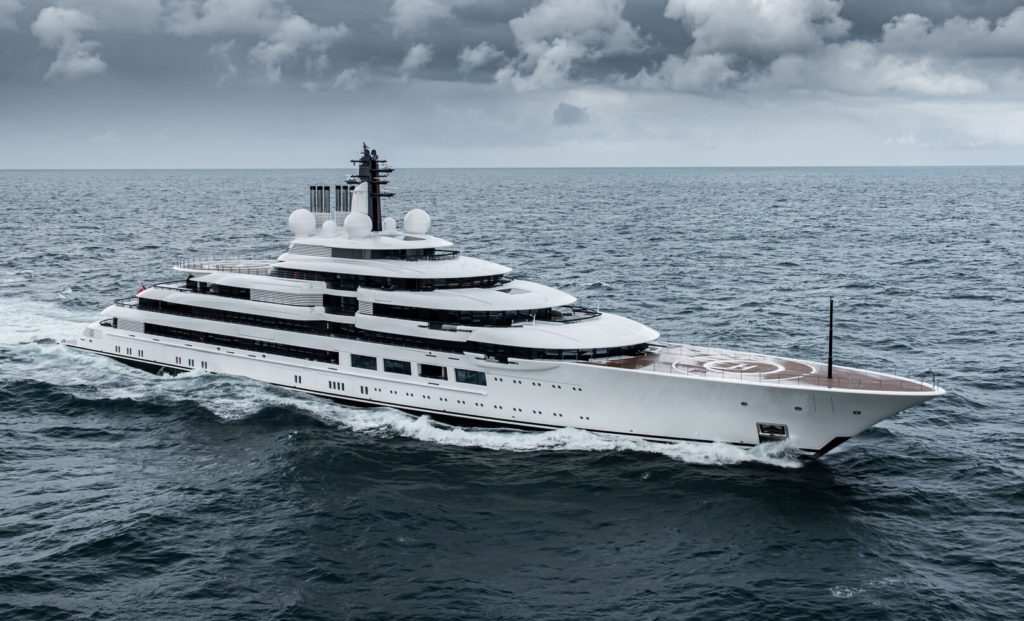
Endless Entertainment aboard Lightning Superyacht
While the Lightning provides a haven for gourmet pleasures and relaxation, it also promises an array of entertainment options that rival the finest resorts. From a fully equipped cinema where you can enjoy the latest blockbusters to a decked-out gym and spa, boredom is an impossibility on this mega yacht. Every moment spent on board is an opportunity for indulgence and enjoyment.
Exploring Exotic Destinations
But the Lightning offers more than just a life of luxury within its opulent confines. It opens doors to some of the world’s most exotic and breathtaking destinations. From the crystal-clear waters of the Mediterranean to the stunning islands of the Caribbean, this superyacht transforms the world into your oyster. Each journey is an exploration of paradise, with the Lightning as your opulent vessel of discovery.
The Epitome of Luxury
In every conceivable aspect, the Lightning superyacht by Lürssen stands as the epitome of luxury. Its awe-inspiring design, its array of world-class amenities, and its unwavering commitment to excellence redefines what it means to sail in style. If you’re seeking an unforgettable journey on the high seas, if you yearn to transcend the ordinary and embrace the extraordinary, look no further than the Lightning. It’s not merely a yacht; it’s a lifestyle, an experience, and an expression of pure opulence.
Setting sail on the Lightning superyacht by Lürssen is not just a vacation; it’s a transformative odyssey. It’s the embodiment of luxury, a symbol of craftsmanship and innovation, and a gateway to some of the world’s most enchanting destinations. If you’re prepared to elevate your maritime adventures to new heights, the Lightning awaits.
Experience the Lightning. Experience true luxury.
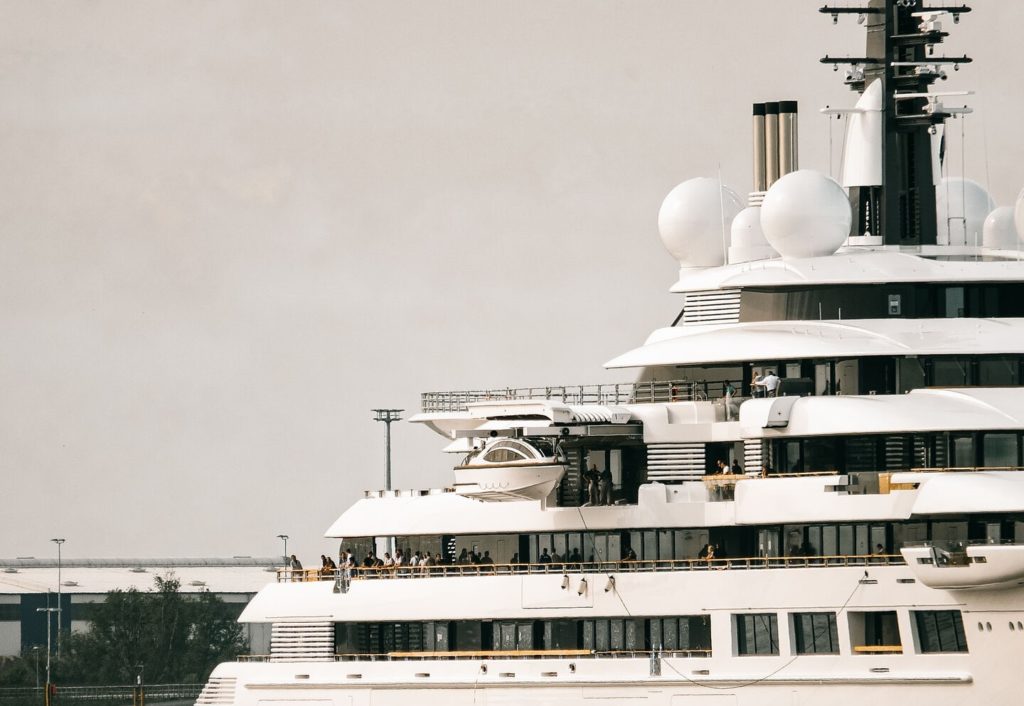
| Name | Lightning |
|---|---|
| Builder | |
| Launched | 5 July 2019 |
| In service | 1 June 2020 |
| Class and type | Motor yacht |
| Tonnage | 10,167 GT |
| Length | 140 m (460 ft) |
| Beam | 23.3 m (76 ft) |
| Draught | 5.1 m (17 ft) |
| Propulsion | 2x 4,963hp MTU (20V 4000 M73L) diesel engines |
| Maximum Speed | 19.5 knots (36 km/h) |
| Cruising Speed | 16.2 knots (30 km/h) |
| Capacity | 40 |
| Crew | 92 |
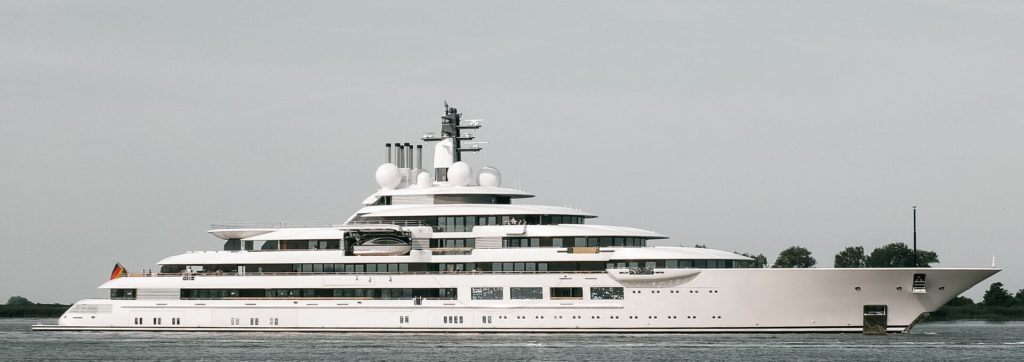
Lightning superyacht Amenities
The Lightning superyacht by Lürssen offers a wide range of amenities, ensuring that guests enjoy the utmost comfort and luxury during their voyage. While the exact amenities can vary depending on the specific design and layout of the yacht, here is a list of common amenities found on many superyachts:
Luxurious Cabins :
Spacious and beautifully appointed cabins with en-suite bathrooms, often featuring stunning ocean views.
Multiple Lounges and Salons :
Various lounges and salons throughout the yacht, each designed for relaxation, socializing, and enjoying the sea views.
Dining Areas :
Elegant dining areas, both indoors and outdoors, where guests can savor gourmet meals prepared by a professional chef.
Cinema Room :
A dedicated cinema room with a large screen and comfortable seating for enjoying movies and entertainment.
Wellness and Spa Facilities :
A fully equipped gym, spa, and wellness center for fitness and relaxation.
Infinity Pool :
An infinity-edge swimming pool on deck, often with a jacuzzi, providing a perfect spot for a refreshing dip with a view.
Water Toys and Sports Equipment :
A collection of water toys and sports equipment, including jet skis, paddleboards, kayaks, and more for water-based activities.
Tender Garage :
A garage housing tenders (small boats) for shore excursions and water sports.
Sun Decks :
Expansive sun decks with sun loungers and sunbathing areas for soaking up the sun.
Some superyachts feature a helipad, allowing for convenient helicopter arrivals and departures.
Library and Study :
A quiet space with a collection of books and a study area for those seeking a tranquil retreat.
Bar and Cocktail Lounge :
A well-stocked bar and cocktail lounge for socializing and enjoying beverages.
Observation Deck :
An observation deck for taking in panoramic views of the surrounding seascape.
Underwater Lounge :
A unique feature on some superyachts is an underwater lounge, providing a window to the underwater world.
Crew Accommodations :
Comfortable living quarters for the dedicated crew who ensure the smooth operation of the yacht.
Advanced Navigation Systems :
State-of-the-art navigation and communication systems for safe and efficient sailing.
Security Measures :
High-tech security systems and measures to ensure the safety and privacy of guests.
Wi-Fi and Connectivity :
Reliable Wi-Fi and connectivity for staying in touch with the world while at sea.
Environmental Initiatives :
Some yachts incorporate eco-friendly technologies and practices to minimize their environmental impact.
Customization :
Many superyachts offer a high degree of customization, allowing owners to tailor the amenities and layout to their preferences.
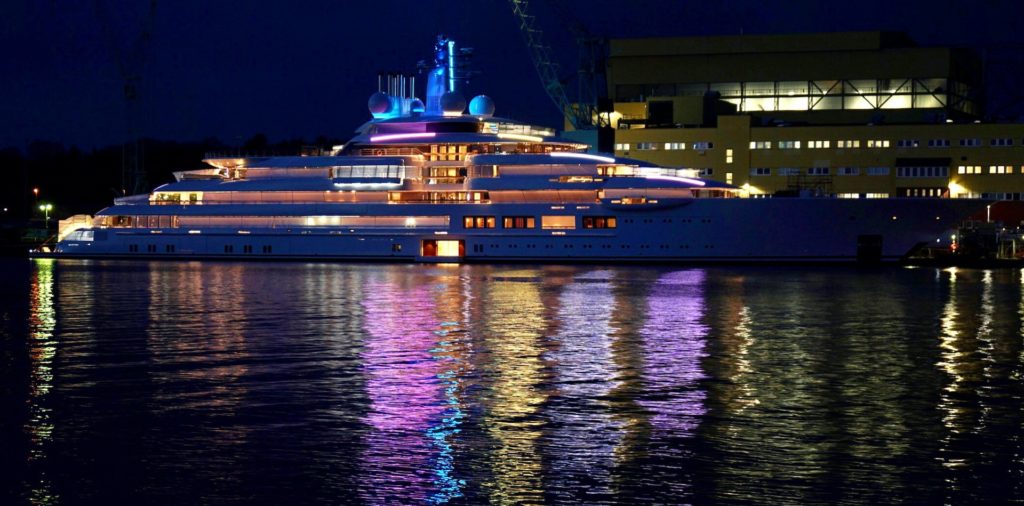
Crew positions onboard Lightning Superyacht and explanation
The captain is responsible for the overall operation of the yacht, including navigation, safety, and compliance with maritime regulations. They make strategic decisions regarding the yacht’s route, weather conditions, and guest activities.
First Officer (Chief Mate)
The first officer assists the captain in navigation and vessel management. They often oversee deck operations, including the crew, maintenance, and safety procedures.
The bosun is in charge of maintaining the exterior of the yacht. They oversee deckhands, manage water sports equipment, and ensure the cleanliness and appearance of the exterior spaces.
Deckhands are responsible for various tasks on the exterior of the yacht, such as mooring, anchoring, and maintenance. They assist with water sports activities and guest transportation.
Chief Engineer
The chief engineer manages the yacht’s mechanical and engineering systems, including engines, generators, and electrical systems. They ensure the smooth operation of all machinery.
Assistant Engineer
The assistant engineer supports the chief engineer in maintaining and repairing technical equipment on board. They often work on a rotating shift schedule.
Steward/ess (Purser)
Steward/esses are responsible for guest services, interior maintenance, and housekeeping. They ensure that guest cabins and common areas are immaculate and attend to guest needs.
The chef is responsible for creating gourmet meals tailored to guest preferences and dietary restrictions. They manage the yacht’s galley (kitchen) and often prepare multiple-course meals.
The sous chef assists the head chef in meal preparation, kitchen management, and provisioning.
Interior Crew
These crew members include waitstaff, housekeepers, and laundry personnel. They maintain the interior, serve meals, and attend to guests’ needs.
Chief Steward/ess
The chief steward/ess oversees the interior crew, manages guest services, and ensures that all guest requests are met efficiently.
The purser manages administrative tasks, including guest accounts, crew payroll, and documentation. They often serve as a liaison between the guests and the crew.

Deck Steward/ess
Deck steward/esses assist with both exterior and interior duties, often helping with service during meal times and maintaining outdoor spaces.
Security Officer
On larger yachts, a security officer may be responsible for the safety and security of guests and crew. They monitor security systems and implement safety protocols.
Nurse/Medical Officer
Some superyachts have a medical officer or nurse on board to attend to the health and well-being of guests and crew.
Tender Operator
Crew members responsible for operating tenders and water sports equipment, ensuring safe transportation of guests to and from shore and overseeing water activities.
Entertainment Crew
On yachts with extensive entertainment options, there may be crew members dedicated to managing the cinema, spa, or other recreational facilities.
Some superyachts employ specialty chefs, such as sushi chefs, pastry chefs, or cocktail mixologists, to enhance the dining experience.
Responsible for preparing meals for the crew and ensuring they have nourishing and satisfying food.
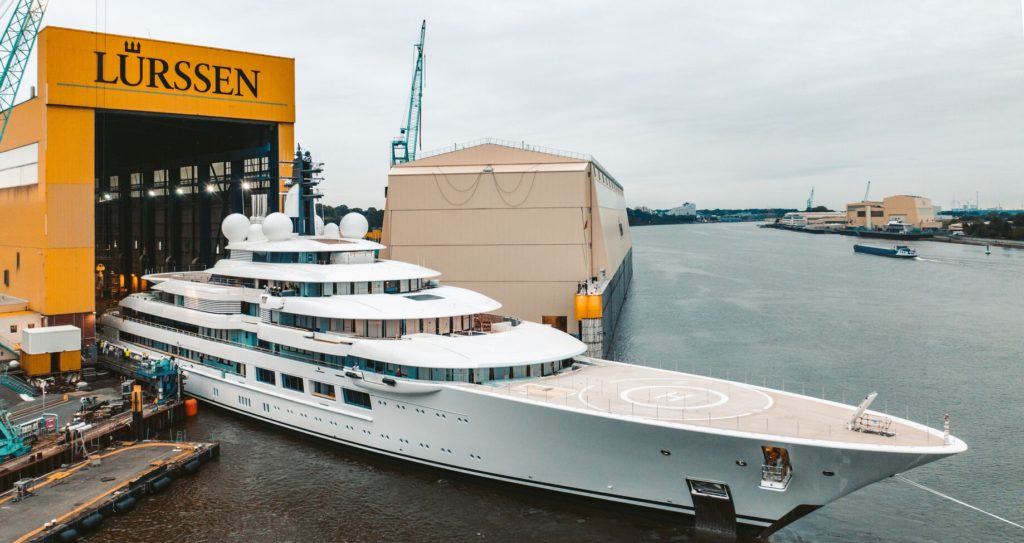
If you want to explore other mega yachts CLICK HERE
Or if you feel lucky and you think that you can find Lightning Superyacht on a map, CLICK HERE to visit our Live tracking map for luxury yachts and other vessels.
Related Images:
Share this with your friends:.
- Yacht Tracking Map Find mega yacht
- Fun Map Map The World
- Privacy Policy
- THE PRINCESS PASSPORT
- Email Newsletter
- Yacht Walkthroughs
- Destinations
- Electronics
- Boating Safety
- Ultimate Boating Giveaway

Supersize Sport-Fishers
- By Chris Caswell
- Updated: January 12, 2021
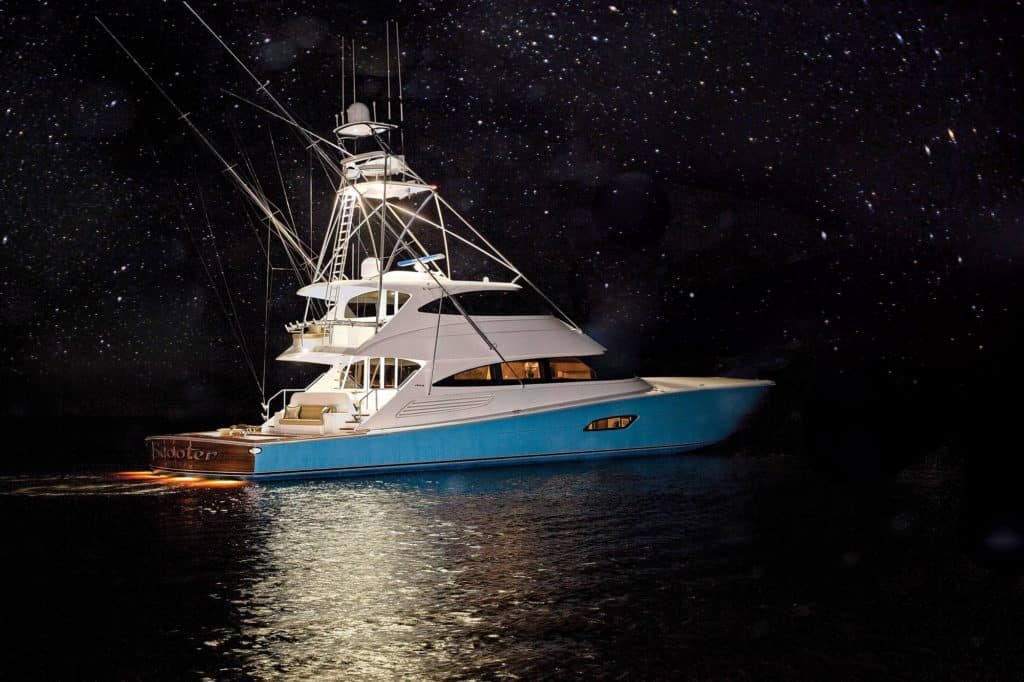
Once upon a time, sport-fishing boats were sized to meet lesser demands. Ernest Hemingway’s Pilar was 38 feet, which was large enough to get him into the Gulf Stream to chase marlin and the occasional U-boat during World War II. The first Rybovich, Miss Chevy II , was just 34 feet long, while the first Hatteras convertible sport-fisher, Knit Wits , pushed the length-overall envelope at 41 feet some 60 years ago.
Today, sport-fishers have soared past the 90-plus-foot mark with regularity, ranging up to the 144-foot Trinity Bad Company (originally Marlena ) that carries a dozen guests and a half-dozen crew on adventures to far-flung fishing grounds.
For years, both production and custom-built sport-fishers have grown. Owners demanded vessels that were bigger and more comfortable for running on their own bottoms from the United States to the fertile Pacific waters of Costa Rica and Guatemala to chase supersize sailfish and blue, black and striped marlin. To chug across the Atlantic for the summer billfish tournaments in Bermuda. To chase world records, wherever the bite was at the moment. It’s an attitude reminiscent of the film Endless Summer , where surfers gallop around the planet in search of the perfect wave.
The builders Viking, Hatteras and Bertram have long been the 900-pound gorillas of production sport-fishers, drawing the line at around 90 feet, with the Viking 92 emerging as a front-runner in this category. To date, Viking has built 19 of its 92-footers, with hull numbers 20 and 21 currently in production. While the Hatteras 92 and Bertram 80 are out of production, they still enjoy popularity on the brokerage market.
On the custom, cold-molded construction side of sport-fish yachts, North Carolina’s Jarrett Bay Boatworks launched the 90-foot Jaruco in 2017. The boat is a 44-knot battlewagon with a foredeck for touch-and-go helicopter landings. And for those who believe wooden hulls raise more fish, Bayliss Boatworks—also in North Carolina—has the 90-foot Reel Wheels II , with five staterooms and 38-knot speed, making quick work of runs to the canyons or back to the scales on tournament day.
In general, the hallmarks of a great sport-fisher, at least those in the 40-to-60-foot range, have included nimbleness when fighting a fish, as well as speed. Today’s larger sport-fishers can compete in those areas as well.
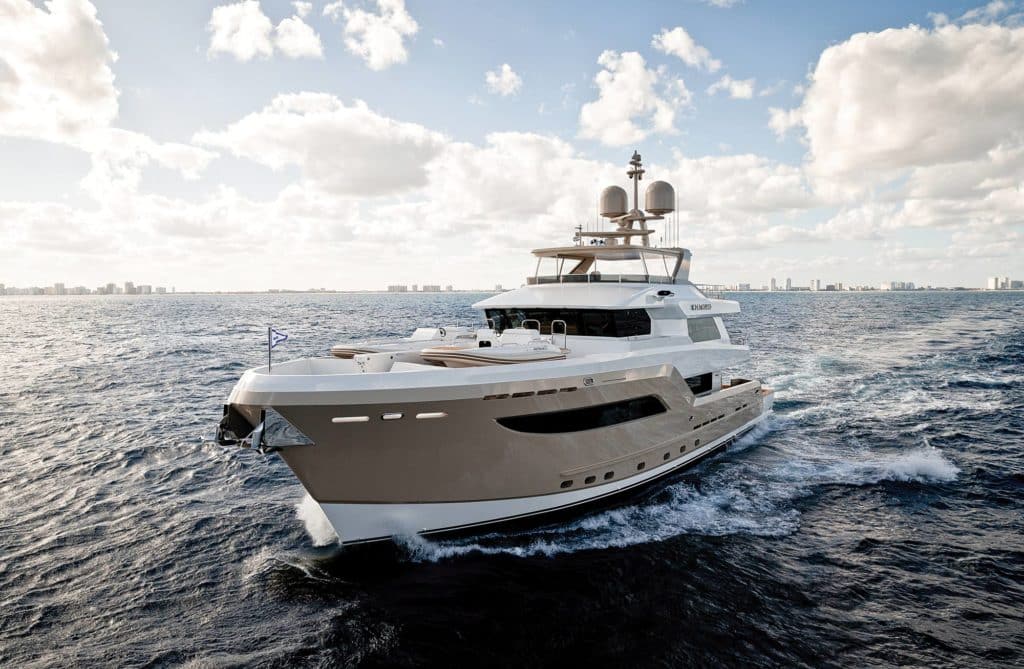
Consider the 92-foot Viking Fa La Me , owned by Frank Rodriguez. It swept the Bermuda Triple Crown tournament series with the highest point total in the event’s history and became the first three-time winner of the series. Another 92-foot Viking, A Work of Art , grabbed second place in the 2017 Orange Beach Billfish Classic release division, and the 95-foot Jim Smith Relentless Pursuit took the tournament in 2019 with a 658.2-pound blue marlin and third-place wahoo.
The reigning queen of the mega-sport-fisher world, though, continues to be Bad Company , which was at first 132 feet length overall and subsequently stretched. Its top speed with twin 3,500 hp Paxman V-12s is 33 knots, which at first blush may not seem special. Keep in mind, however, that a 300-gross-ton 144-footer traveling at 33 knots can maintain that speed in rough seas while smaller, albeit faster sport-fishers have to pull the throttles way back. The amount of hull in the water matters.
The newest of the big-gun sport-fishers is the 130-foot Lanakai . Michael Peters designed it, and New Zealand’s Yachting Developments built it. It is the largest carbon-fiber sport-fisher and has twin 3,150 hp V-12 MTU 4000 M93 diesels that reportedly push it to 30 knots while carrying 10 guests and six crew in superyacht style.
So what changed to make larger sport-fishers tournament-viable, aside from owners being willing to spend considerably more money on a bigger boat?
First, of course, is maneuverability, which is essential—especially when faced with an angry blue marlin. Hydraulic bow thrusters are a key component of these vessels, allowing a captain to position the yacht precisely when backing down hard. Captains describe the big sport-fishers as being just as nimble as smaller boats.
On Fa La Me , one of the secret weapons is the fly-by-wire Viking independent programmable electrohydraulic rudders, eliminating the tie bars between rudders, and allowing independent rudder control, much like pod drives but with conventional shafts and props. The setup optimizes maneuverability at low speeds. Add to that modern technology such as joystick controls, which make the captain’s job easier. Two fingers on a joystick on the bridge rail keeps the yacht perfectly positioned for the crew in the cockpit.
Available horsepower has also driven up the sport-fisher’s length overall, with up to 7,000 hp now tucked into engine rooms for hammer-down power. Add in other technology such as gyrostabilizers that make a yacht more secure for stand-up tackle, and the result is large sport fishing yachts that are as agile as smaller sport-fishers in the hands of an experienced helmsman.
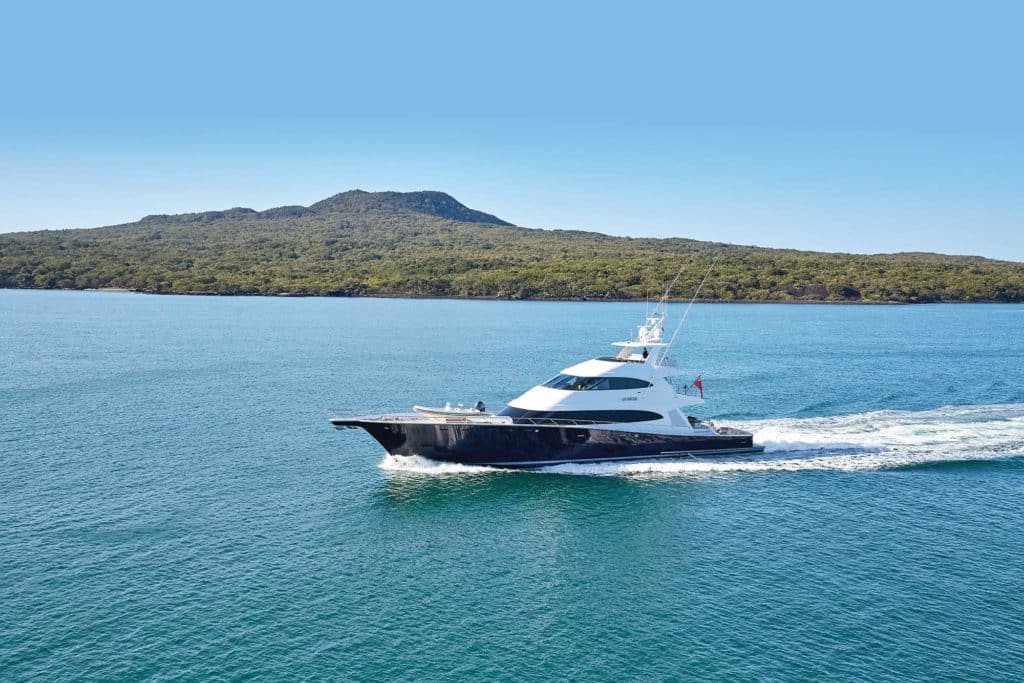
Sheer size has other benefits. Consider the cockpit on Bad Company , which spans the vessel’s 27-foot beam. A half-dozen crew can be prepping bait and rigging lines and leaders, and never be crowded. That same width also allows outriggers that spread 120 feet to get lines into clean trolling lanes.
Mega-sport-fishers also have more balconies and mezzanines than Italy’s La Scala opera house, so it’s easier to keep a eye on the spread. Three decks on most offer good viewing of the fishing action. And the height matters. A taller flybridge allows for better visibility than tuna towers on smaller craft.
Larger yachts also mean more rod-and-tackle stowage and immense fridges and freezers with multiple ice chippers to keep the catch fresh and cool. Enclosed bridges provide comfort on extended passages as well as weather protection on snotty days.
The owner of Lanakai , according to Peters, puts those and other features to good use. “This owner is an absolute sportsman and adventurer,” Peters says. “He wants to stay out for weeks. He wants to fish Fiji and the [Great] Barrier Reef. He wants to roam far and wide in search of big fish. He had an 85-footer, and it simply wasn’t big enough for his goals. Besides, it’s not just about fishing; a water-level cockpit gives great access to the water for diving too.”
This type of boat is indeed a beautiful thing. As Luiz de Basto, designer of the 105-foot Broward Odyssey and the 95-foot Seaforce IX sport-fisher series, puts it: “Something that I, as a yacht designer, realized many years ago is that the pure, classic fishing boat—its unique purpose and the resulting lines—are probably the most original creation of the vast and diverse American pleasure-boat universe. From 30-footers to the largest ones, they all share a sporting purpose and beautiful elegance that demonstrates America’s ingenuity at its best.”
The style also represents fishing at its finest. Sam Gershowitz—owner of the Star Island Yacht Club and Marina in Montauk, New York—is a serial owner of sport-fishers, all named Marlena . His current big gun is a 105-foot Jim Smith. When asked how he planned to fish the boat, his answer perfectly summed up mega-sport-fishers: “very comfortably.”
- More: Burger Boat Company , November 2020 , Sportfish Yachts , Sportfishing Boats , Viking Yachts , Yachts
- More Yachts

Top Nine Fishing Tenders For 2024

First Look: Meet the Apreamare 88 Motoryacht Flagship

Holterman Shipyard Debuts Xtreme X-65

Unveiling the Tiara Yachts EX 54: A Comprehensive Review

Unforgettable Caribbean Voyage: Sailing Through St. Maarten and Dominica

Next-Level Cruising: 2022 Palm Beach PB70 For Sale

For Sale: 2014 Sabre 42 Salon Express

- Digital Edition
- Customer Service
- Privacy Policy
- Terms of Use
- Email Newsletters
- Cruising World
- Sailing World
- Salt Water Sportsman
- Sport Fishing
- Wakeboarding
Advertisement
Supported by
Lynch Yacht Sinking Off Sicily Proves as Baffling as It Is Tragic
As bodies were recovered, the authorities and experts wondered how a $40 million, stable and secure vessel could have sunk so quickly.
- Share full article

By Emma Bubola and Michael J. de la Merced
Emma Bubola reported from Porticello, Italy, and Michael J. de la Merced from London.
Two months after being cleared in a bruising legal battle over fraud charges, the British tech mogul Mike Lynch celebrated his freedom with a cruise. He invited his family, friends and part of his legal team on board his luxury sailing yacht, a majestic 180-foot vessel named Bayesian after the mathematical theorem around which he had built his empire.
On Sunday night, after a tour of the Gulf of Naples, including Capri, and volcanic islands in the Eolian archipelago, the boat anchored half a mile off the Sicilian coast in Porticello, Italy. It chose a stretch of water favored by the Phoenicians thousands of years ago for its protection from the mistral wind and, in more recent times, by the yachts of tech billionaires. The boat was lit “like a Christmas tree,” local residents said, standing out against the full moon.
But about 4 a.m., calamity unfolded. A violent and fast storm hit the area with some of the strongest winds locals said they had ever felt. Fabio Cefalù, a fisherman, said he saw a flare pierce the darkness shortly after 4.
Minutes later, the yacht was underwater. Only dozens of cushions from the boat’s deck and a gigantic radar from its mast floated on the surface of the sea, fishermen said.
In all, 22 people were on board, 15 of whom were rescued. Six bodies — five passengers and the ship’s cook — had been recovered by Thursday afternoon, including that of Mr. Lynch, an Italian government official said, adding that the search was continuing for his daughter.
It was a tragic and mystifying turn of events for Mr. Lynch, 59, who had spent years seeking to clear his name and was finally inaugurating a new chapter in his life. Experts wondered how a $40 million yacht, so robust and stable could have been sunk by a storm near a port within minutes.
“It drives me insane,” said Giovanni Costantino, the chief executive of the Italian Sea Group, which in 2022 bought the company, Perini, that made the Bayesian. “Following all the proper procedures, that boat is unsinkable.”
The aura of misfortune only deepened when it emerged that Stephen Chamberlain, 52, a former vice president of finance for Mr. Lynch’s former company and a co-defendant in the fraud case, was killed two days earlier, when he was hit by a car while jogging near his house in England.
Since June, the two men had been in a jubilant mood. A jury in San Francisco had acquitted both on fraud charges that could have sent them to prison for two decades. There were hugs and tears, and they and their legal teams went for a celebratory dinner party at a restaurant in the city, said Gary S. Lincenberg, a lawyer for Mr. Chamberlain.
The sea excursion was meant as a thank-you by Mr. Lynch to those who had helped him in his legal travails. Among the guests was Christopher J. Morvillo, 59, a scion of a prominent New York family of lawyers who had represented Mr. Lynch for 12 years. He and his wife, Neda, 57, were among the missing.
So, too, was Jonathan Bloomer, 70, a veteran British insurance executive who chaired Morgan Stanley International and the insurer Hiscox.
The body of the ship’s cook, Recaldo Thomas, was recovered. All the other crew members survived. Among them was Leo Eppel, 19, of South Africa, who was on his first yacht voyage working as a deck steward, said a friend, who asked not to be identified.
Since the sinking, the recovery effort and investigation have turned the tiny port town of Porticello, a quiet enclave where older men sit bare-chested on balconies, into what feels like the set of a movie.
Helicopters have flown overhead. Ambulances have sped by with the sirens blaring. The Coast Guard has patrolled the waters off shore, within sight of a cordoned-off dock that had been turned into an emergency headquarters.
On Wednesday afternoon, a church bell tolled after the first body bag was loaded into an ambulance, a crowd watching in silence.
The survivors were sheltering in a sprawling resort near Porticello, with a view of the shipwreck spot, and had so far declined to comment.
Attilio Di Diodato, director of the Italian Air Force’s Center for Aerospace Meteorology and Climatology, said that the yacht had most likely been hit by a fierce “down burst” — when air generated within a thunderstorm descends rapidly — or by a waterspout , similar to a tornado over water.
He added that his agency had put out rough-sea warnings the previous evening, alerting sailors about storms and strong winds. Locals said the winds “felt like an earthquake.”
Mr. Costantino, the boat executive, said the yacht had been specifically designed for having a tall mast — the second-tallest aluminum mast in the world. He said the Bayesian was an extremely safe and secure boat that could list even to 75 degrees without capsizing.
But he said that if some of the hatches on the side and in the stern, or some of the deck doors, had been open, the boat could have taken on water and sunk. Standard procedure in such storms, he said, is to switch on the engine, lift the anchor and turn the boat into the wind, lowering the keel for extra stability, closing doors and gathering the guests in the main hall inside the deck.

12 guests occupied the yacht’s six cabins. There were also 10 crew members.
Open hatches, doors and cabin windows could have let in water during a storm, according to the manufacturer.

Open hatches, doors and
cabin windows could
have let in water
during a storm,
according to the
manufacturer.
Source: Superyacht Times, YachtCharterFleet, MarineTraffic
By Veronica Penney
The New York Times attempted to reach the captain, James Cutfield, who had survived, for comment through social media, his brother and the management company of the yacht (which did not hire the crew), but did not make contact.
So far none of the surviving crew members have made a public statement about what happened that night.
Fabio Genco, the director of Palermo’s emergency services, who treated some of the survivors, said that the victims had recounted feeling as if the boat was being lifted, then suddenly dropped, with objects from the cabins falling on them.
The Italian Coast Guard said it had deployed a remotely operated vehicle that can prowl underwater for up to seven hours at a depth of more than 980 feet and record videos and images that they hoped would help them reconstruct the dynamics of the sinking. Such devices were used during the search and rescue operations of the Titan vessel that is believed to have imploded last summer near the wreckage of the Titanic.
After rescuers broke inside the yacht, they struggled to navigate the ropes and many pieces of furniture cluttering the vessel, said Luca Cari, a spokesman for Italy’s national firefighter corps.
Finally, as of Thursday morning, they had managed to retrieve all but one of the missing bodies, and hopes of finding the missing person alive were thin. “Can a human being be underwater for two days?” Mr. Cari asked.
What was certain was that Mr. Lynch’s death was yet another cruel twist of fate for a man who had spent years seeking to clear his name.
He earned a fortune in technology and was nicknamed Britain’s Bill Gates. But for more than a decade, he had been treated as anything but a respected tech leader.
He was accused by Hewlett-Packard, the American technological pioneer that had bought his software company, Autonomy, for $11 billion, of misleading it about his company’s worth. (Hewlett-Packard wrote down the value of the transaction by about $8.8 billion, and critics called it one of the worst deals of all time .) He had been increasingly shunned by the British establishment that he sought to break into after growing up working-class outside London.
He was extradited to San Francisco to face criminal charges, and confined to house arrest and 24-hour surveillance on his dime. In a townhouse in the Pacific Heights neighborhood — with security people he jokingly told associates were his “roommates” — he spent his mornings talking with researchers whom he funded personally on new applications for artificial intelligence. Afterward, he devoted hours to discussing legal strategy with his team.
Despite his persistent claims of innocence, even those close to Mr. Lynch had believed his odds of victory were slim. Autonomy’s chief financial officer, Sushovan Hussain, was convicted in 2018 of similar fraud charges and spent five years in prison.
During Mr. Lynch’s house arrest, his brother and mother died. His wife, Angela Bacares, frequently flew over from England, and she became a constant presence in the San Francisco courtroom during the trial.
After he was finally acquitted, Mr. Lynch had his eye on the future. “I am looking forward to returning to the U.K. and getting back to what I love most: my family and innovating in my field,” he said.
Elisabetta Povoledo contributed reporting from Pallanza, Italy.
Emma Bubola is a Times reporter based in Rome. More about Emma Bubola
Michael J. de la Merced has covered global business and finance news for The Times since 2006. More about Michael J. de la Merced
672 Wine Club
- Motorcycles
- Car of the Month
- Destinations
- Men’s Fashion
- Watch Collector
- Art & Collectibles
- Vacation Homes
- Celebrity Homes
- New Construction
- Home Design
- Electronics
- Fine Dining
- Benchmark Wines
- Brian Fox Art
- Chase United
- Disneyland Resort
- Sports & Leisure
- Health & Wellness
- Best of the Best
- The Ultimate Gift Guide
The 10 Best Explorer Yachts for High-Seas Adventures
A 350-foot gigayacht or 60-foot cruiser size isn't what defines an explorer yacht. the devil's in the details when it comes to authenticity., julia zaltzman, julia zaltzman's most recent stories.
- These Charter Yachts Let You Tag Hammerhead Sharks and Count Spirit Bears for Research
- These Luxe Villas Are the Place to Stay in This Retro-Chic Enclave on the Tuscan Coast
- The 7 Most Exciting New Superyacht Marinas in the World
- Share This Article

Unlike fashion trends that seem to move as fast as a Redbull F1 car, the yachting industry takes its time adopting new ideas. There seems to be one exception. Explorer vessels, born out of the owners’ desires to go farther and stay longer, without sacrificing creature comforts, is developing with some urgency.
Several dozen builders and designers are now focusing on explorers, but they are also consulting with adventure travel firms that have a long history of using expedition yachts in remote parts of the globe. ICON Yachts, for example, collaborated with Cookson Adventures and the International Seakeepers Society on its Project Mission in both the overarching design and the details found across the yacht. Adventure outfitter EYOS employs its expertise routinely with Damen’s explorer vessels, most recently with the 190-foot Pink Shadow. EYOS has a list of 50 features that separate authentic explorers from faux versions that might look the part but lack the necessary infrastructure and design elements.
Long-range cruising, system redundancy for autonomy at sea, and storage to carry specialist equipment like submersibles are some of the requirements that define expedition boats. There’s also deck configuration for the easy launch of tenders and toys, along with strong, ice-class hulls and climate-controlled areas comfort in extreme polar and tropic regions.
We culled through the latest fleet of explorers with multiple lengths and designs, selecting a single feature that we think makes it best in class. Here are 10 of our favorites.
Best Pilothouse: Doggersbank 77 Offshore

More than 700 Doggersbank motoryachts have been built since the 1960s, with the latest model scheduled for delivery in 2025. The robust, offshore vessels are designed by Dutch studio Vripack for long ocean passages, assisted by a high, flared bow. “It prevents green water from hitting the wheelhouse windows in rough seas, and together with the Portuguese bridge, ensures the captain’s view is not obstructed,” Joost Mertens, Doggersbank fleet manager, told Robb Report . “The yacht’s steel hull ensures the yacht sits better in the water making it less vulnerable to wind and high waves.”
Best Deck Configuration: Columbus Crossover 42

The Columbus Crossover 42 is defined by both straight and angled surfaces, tapered stern sections and a concentration of volume in the bow that is becoming on many explorers. What is atypical is the yacht’s compact but flexible dimensions that accommodate a large cockpit tender and a 108-square-foot swimming pool with relaxation areas. Sold to an U.S. customer, it’s scheduled for delivery in 2025.
Best Multipurpose Stern: Bering B165

Turkish boatbuilder Bering Yachts revealed details of its new 162-foot flagship explorer yacht, the B165 , at the Dubai International Boat Show in March. The yacht can carry 18,400 gallons of fuel, which the builder says will give it a 4,000 nautical mile range when cruising at 12 knots. It also has a 2,640-gallon holding tank. What singles the B165 out among other explorers, however, is its multi-purpose stern area for both function and form. The elongated aft deck has a swimming pool surrounded by sunbeds. When the bulwarks are folded down, the space becomes an even larger overwater terrace. When the pool is not in use, it can be used as a covered storage area for water toys and expedition equipment. The yacht’s two tenders are also stored on the aft, making it a flexible space for both equipment and guests.
Best Family-Friendly Concept: Project Mimer

This 197-foot expedition concept by Tillberg Design of Sweden caters to family travel with a helicopter pad as well as multiple tenders and toys. It’s pitched by the studio as an introduction to true explorer yachting. It has a functional crew layout for efficient operations and an upper deck owner’s suite with a forward terrace and spa pool. With a hull that will be built to the Polar Code Category, the concept also has an optional helipad aft and long list of toys, from an electric luxury tender and two expedition RIBS to quad bikes, a submersible, Jet Skis, and, of course, an amphibious vehicle. The five-decked yacht sleeps 12 guests with crew quarters for 17 and an additional staff member, such as a nanny.
Best Ice Explorer: Damen SeaXplorer 105

Damen’s 345-foot SeaXplorer 105 is the largest model in the SeaXplorer range, with exterior design by Azure Yacht Design. The platform was developed under the guidance of expedition specialists EYOS Expeditions, who considered over 150 design criteria, from the hull form and bridge layout to the tender davits and Zodiac boarding arrangements. But it is EYOS’s expertise in the polar regions—it facilitated the first heli-ski charter in Antarctica and the first 3,200-foot sub dive to the Antarctic midnight zone—that gives the vessel its point of difference. The SeaXplorer has an ice-strengthened hull and a specially shaped icebreaking stern to maneuver through rough terrain.
Best Interior: Project Fox

On top of having a cool name, Project Fox has a bright, contemporary interior, courtesy of London’s Q Design, that is becoming more common on expedition yachts. The full-beam owner’s stateroom is also one of the yacht’s standout features, with its marble en suite and hardwood floors. The salon is also luxe, with white walls that brighten up travel even in areas that are sunlight deprived. Project Fox also has four other staterooms.
Best Autonomy: Project Master

ICON Yachts’s Project Master was a transoceanic offshore support vessel before the Dutch shipyard began a refit to turn it into an explorer yacht (see before and after inset). It’s equipped with diesel-electric hybrid propulsion, a wide beam for multiple tender spaces, a 7,200-nautical mile range, and flexible cabin arrangements for expedition crew. Other features include a science lab and a certified heli-deck. “The yacht’s helicopter and sub capability mean it can offer assistance in areas with challenging access and little infrastructure,” Micca Ferrero, owner of ICON Yachts, told Robb Report . “The design is for the demands of self-sufficient voyages.”
Best Use of Volume: Arcadia Yachts A96

The A96 mixes the lines, volume, and open-plan layout of Arcadia’s Sherpa series with the speed, joystick maneuverability, and quality of the yard’s A range. It’s the first Arcadia to have an Igor Lobanov-designed interior, as well as a high bow and high deckheads for traversing rough water. But its big differentiator is the 214 gross tonnes of volume and 24-foot beam that generate big volumes—4,300 square feet of usable space, which is 30 percent more than on other similar-sized yachts. Low bulwarks and lateral walkways emphasize the sense of openness.
Best Bow: Project Shackleton

This 351-foot build from Lürssen has an inverted bow that looks like an eagle’s beak. The shape is designed to slice through waves with much lower vibration through the hull, while also reducing rock and roll in rough seas. Unlike the quasi-research vessel exteriors of many explorers, this vessel is representative of the changing look of many in this growing segment.
Best Multi-Mode Hull: Azimut Magellano 60

The Magellano 60 isn’t technically an explorer yacht. Think of it as a cruiser designed for some long-distance travel. But it does have one very interesting feature, what its builder Azimut calls a “dual-mode” hull. The semi-planing shape is designed to optimize fuel consumption (and therefore lower emissions) by about 20 percent (compared to similar-sized vessels) at low and medium speeds. The yacht’s bow is also designed to cut through waves for better seakeeping at a range of speeds. The boat cruises very efficiently at 18 knots but will hit a top end of 26, thus delivering the performance of a planing hull with the benefits of a displacement hull.
Read More On:
- Expedition Yachts
- Explorer Yachts
More Marine

Kevin Costner Cruised on This Luxe 75-Footer Last Summer. Now It’s Debuting at Cannes Yacht Fest.

This New 161-Foot Explorer Yacht Offers 6 Days of Autonomy at Sea

Luxury Riverboats Are Giving Superyacht Charters a Run for Your Money

The ‘Titanic”s Iconic Bow Deck Has Partially Fallen Off, an Expedition Finds

Meet the Wine Club That Thinks Differently.
Receive editor-curated reds from boutique California producers four times a year.
Give the Gift of Luxury
Latest Galleries in Marine

Leapher Yachts Navix50 in Photos

10 Must-Haves That Will Make Your Yacht Trip Even Better
More from our brands, celebrities front row at ralph lauren spring 2025: first lady jill biden, usher, jude law and more, ravens, chiefs draw 23-year ratings high in blockbuster nfl opener, saudi film pioneer faisal baltyuor launches first arthouse cinema in riyadh where titles will include ‘the zone of interest,’ ‘fallen leaves’ (exclusive), derek boshier, british pop artist who made work for david bowie and the clash, dies at 87, the best yoga mats for any practice, according to instructors.

10 Tips for Sailing In Heavy Weather

Last Updated by
Capt Chris German
June 15, 2022
They say that calm seas never made a great sailor. Rough seas and heavy wind are just a right of passage for many. I however would argue that the best sailors are those who manage to avoid heavy weather entirely.
Reading a weather report and planning one’s voyage to avoid nasty weather is the best call of them all. But, if you find yourself under gloomy skies and heavy chop unexpectedly, then getting yourself back to shore becomes paramount.
Here are a few tips for bad weather sailing that have helped salty sailors stay safe.
Table of contents
1. An ounce of prep saves a pound of trouble
Whether it’s replacing the impeller before it goes bad or coiling lines properly before you head out, preparation is the name of the game when it comes to sailboats. They say that the average sailor spends 10 hours working on a boat for every hour sailing and that’s just about how it should be. Making sure everything is working and properly cared for is a full time job and if you're not putting in the hours to keep your boat in tip top condition, your boat will fail you just when you need it most.
Things to watch out for when prepping for bad weather include:
- Scuppers are clean and free flowing. An errant acorn or a wad of tape can turn an otherwise seaworthy boat into a bathtub. Heavy rain and/or crashing waves have been known to sink a vessel that could not properly ship water overboard. Take the time to make sure your scuppers can save your boat and your life in heavy conditions.
- An orderly boat is a safe boat and that includes properly coiling lines. If you don’t know how to properly coil a line then you should learn asap. You never know when you will need to cast off a line or drop a sail in a hurry. Making sure that all your lines are properly coiled ensures that a line will run freely without kinks or “ass holes” when you need it to.
- Engine maintenance is all too often forgotten on sailboats. In heavy weather, bare poles are sometimes much safer than sails and a good working motor can be the difference between life and death. Changing the oil, checking belt tension and visually inspecting through hull fittings should be part of common practice on your boat. Having back up supplies like an impeller, hoses and belts are also part of good maintenance and you should regularly check your supplies and replace them when they get used.
2. Reef early, reef often
If you read last week’s piece on reefing , you may think I am beating a dead horse. But I can’t stress enough the importance of reefing in heavy weather. A better alternative to reefing is using the right sail for the right conditions. Many a genoa jib has been reduced to shreds in heavy air when a skipper fails to change sails in a timely manner.
Much like reefing, which should be done before you actually need to, so too should you raise your storm jib and douse your main before the heavy weather starts. Making the call to reduce sail or go bare poles can be a life saving call when made at the appropriate time. If you don't know how to reef or have difficulty changing sails, you should refrain from sailing in heavy air until you have had a chance to practice in lighter conditions.
3. File a float plan
In this day and age with cell phones and email, we often think help is just a text message away. At sea, especially in heavy air, sending a text message or making a phone call can be impossible.
Rain, wind and waves can kill a cell phone and if you doubt that, here’s a little virtual experience of sailing in heavy weather.
Put on all your foul weather gear, turn your shower on full blast cold and have your partner bring the garden hose into your bathroom. Then stand in the shower while your partner sprays you with the hose. For an even more real experience, crumple up $100 dollar bills and flush them down the toilet while you're at it. Then you will realize that using a cell phone in heavy weather is nearly impossible.
That is where the float plan comes into play. By leaving a detailed account of your planned voyage in writing with someone who cares about you, you will ensure that when you are late someone will miss you. And I can’t stress that you leave your float plan with someone who cares about you enough to miss you if you don’t show back up.
In the marina office where I currently work, one of our guests left a float plan with our staff saying that if they weren’t heard from by June 30th that we should send out a search and rescue mission. I found that note on the peg board in our office on July 22. I never heard if they made it back but didn’t see them on the news either so I am hoping they are safe.
But who knows, they may be stranded in the back of some canyon and 10 years from now we will hear about their amazing survival story.
4. Avoid glass and label your can goods
In rough seas, the galley becomes a battlefield. The pitch and yaw of rough seas and gusty winds can turn a dutch oven into a scud missile. Things like glass jars and wine glasses soon become shrapnel as objects fling themself out of cupboards and smash on bulkheads and cabin floors.
When I was buying my endeavour 42, I hired a delivery captain to fit out the boat and sail it from Tampa Bay to Marathon Florida. As part of his job, he needed to buy living supplies to stay on the boat for three weeks as we brought the boat north to Beaufort, NC.
He bought all sorts of cool things like new pots and pans and a full set of flatware. He also bought a very nice french press coffee pot with a tempered glass cylinder to maximize flavor and keep coffee steaming hot. That coffee pot cost me $50 and lasted barely a mile and half out of port when a wake launched that glass cylinder against the bulkhead. Glass is tough on a sailboat.
That being said, I do love storing dry goods in mason jars afloat. Sure they break often enough, but they are relatively cheap to replace and ensure a watertight seal for your flour, rice, beans, oats and other dry goods that go bad in salty places in plastic bags.
You can protect them in the cupboard with silicone webbing available at most big box stores and online megamarts. But who is really gonna indict Grandma’s go to for preserving peaches when all it costs you a $1 worth of oats when it crashes to the deck.
Another good alternative for heavy weather life aboard ship is can goods. They are battle tested and virtually impermeable, even when stored in dank old dark holds of a sailboat. The drawback with can goods is you have to open them to see what’s inside when the humidity and seawater peel off the labels and melt them into bilge sludge.
Do yourself a favor and label them before you put them in the galley locker. Three days at sea with water seeping into every uncaulked hole can make even the most astute seaside chef scratch their head when they pull an unmarked can from the hold. Is it creamed corn or is it canned peas? Do you want to have to open five different cans of food to find the canned tomatoes you were looking for? Label everything in advance with a good label maker .
5. Head lamps, batteries, and darkness
The first night you find yourself wedging your bags around your body to keep you in the bunk while you try to sleep, you will realize life aboard ship in foul weather is tough. And it becomes even tougher when the darkness sets in and you are trying to preserve night vision so the on duty crew can keep the boat upright while the winds and waves batter them on deck.
Headlamps and good batteries are a must. One hand is always for you and the other is always for the boat so if you have to carry a flashlight to empty your bladder on a pitching boat deck in the middle of the night, you will likely hurt yourself.
By strapping on a headlamp ( preferably one that has a night vision setting - you know the red light that is used on submarines in the movies), you will keep both hands free to move about the cabin and perform on deck functions. You will get so much use out of a headlamp on a boat that you ought to bring back up batteries for it and for any other battery operated things you might have like fans, radios and other items.
A darkened ship is a different world and to be safe at night especially when it is rough weather requires that everyone respect each other's night vision while underway. A good headlamp with lots of back up power will make your life so much better that you’ll want to go sailing sometime soon again, even if you step off the boat after this storm and say” I’m never doing this ever again.”
6. The ditch bag - your secret weapon
All cruisers who go off shore are familiar with the ditch bag. It’s usually a waterproof bag that holds your important papers, credit cards, passport, medication, cell phone and other important stuff you might need if the boat goes down. But you don't have to be on a cross Atlantic blue water adventure hailing a mayday to enjoy the benefits of a ditch bag. When the weather turns foul, a waterproof ditch bag is a great place to put all your important stuff to keep it from getting saturated.
The nice part about a personal ditch bag is you can put anything you want in it. It will be there if the boat goes down, but it will also be safe even if the boat doesn’t go down and it just gets soaked by an improperly dogged down hatch or porthole. There are all kinds of good ditch bags and ways to protect your stuff, but one I really like and I am happy to call my friends is UGO.
It’s a neoprene carrying case for your cell phone and keys, but now they have an even larger tablet version which can hold even more stuff. But what’s so great about a waterproof carrying case for your phone you ask? Well this one floats just in case your vee birth fills with water and all you stuff get saturated in a pile on the deck.
You can rest assured that your wallet, cell phone and keys will float at the top of the pile and stay safe and dry in a UGO dry pouch. To be totally clear, Mel and Vicky are really great friends of mine, but I would advocate for UGO even if I didn’t know them because it’s just such a cool idea. You can check them out at most of the boat shows to see these things in action or head over to their website .undefined
7. Reach out to someone - from the middle of nowhere
Since I'm talking about great ideas and better deals let me also introduce you to the newest deal in Satellite Phones.
For far too long, Sat phones have been the privilege of the well-to-do who were not so well connected. If you wanted to go where the wild things were, you had to give up your connection to civilization or pay $1000 for a sat phone.
Since moving to Utah, I have found out how hard it is to make a call when service is spotty and quite frankly if I had had one of these phones on a few of my deliveries offshore, I wouldn’t have had so many run ins with bad weather- more on that in the next section.
While a brand new sat phone with data will run you upwards of $2000, Amazon has a refurbished sat phone for just $200 and plans for just $90 per month for Global Star and Nexus Wireless. We found this to be quite affordable and provide us with a ton of peace of mind while we are either on a mountain top in Utah or 50 miles off the coast of Florida.
Now I am not saying this phone will allow me to live stream to Facebook from the middle of the Gulf of Mexico, but what it will do is allow me to stay connected with shore, get weather updates and ensure I can reach help if I ever need it.
A Sat Phone should be part of everyone’s heavy weather operational plan and if you have any questions about whether it’s right for sailing in heavy weather or not, I point your attention to SV Delos and their voyage to the Azores last year .
They posted a daily update with conditions and stories to their Facebook page and their huge following 1000 miles from the nearest cell tower and always stayed in touch. Now that there are affordable sat phone solutions and even more affordable plans with Nexus Wireless, no one should head offshore or into heavy weather without one.
8. Know your weather before it hits you
The biggest thing about heavy weather sailing is the heavy weather. If you can avoid the nasties then why don’t you?
There are lots of tricks to tell where the wind is going to go next, but the best bet for weather prognostication I have found is satellite weather from Sirius XM. It’s not that expensive and you do have to buy some gear for your boat, but once I was hooked up, I got live weather updates laid over my gps screen and live lightning and winds warnings too. It really changed my world and after my experience on a 36 lagoon off the coast of Florida, I will never sail without XM weather ever again.
We were sailing out of Tampa once again on our way to do a delivery to Beaufort. We had been out for a week and the winds were light and variable the whole time. This meant that we had to motor most of the way and that caused us to blow a gasket on our starboard motor just outside Port St. Lucie.
When we put in, and because most of the trip was hot and boring and now a motor was dead, most of my crew decided to fly home and that left me and my buddy Jay to take this boat the rest of the way back to North Carolina, on one motor.
We decided to go at 6pm on a Tuesday.
We sailed through the first night without incident and by the time the sun rose the next morning, the wind had freshened just a bit and we were making a cool 5 knots some twenty miles off Melbourne. By midday we had reached Daytona Beach and off in the distance we could see dark clouds building.
By 3pm, we found ourselves darting between downpours and lightning strikes but it was until we eyed St. Augustine that the roll cloud appeared. With no cell phone and no weather info, we decided to make a bee-line for St. Austine and hoped to make it inside before the roll cloud reached us. We didn’t make it.
I could see the wall of wind rolling towards us from at least 10 miles off. The calm blue green seas turned in foam streaked torrents as the 75 mile an hour breeze streaked towards us. I told Jay to take the helm and I darted up to the mast to drop the main. It came down with a loud thump into the stack pack and then I turned my interests to the roller furled jib.
We had noted that it was incredibly difficult to turn due to a worn out bearing in the base, but failed to fix it while we were in the safety of the Gulf. Now that we were on blue water and all hell was about to break loose I regretted that, as I struggled to furl the jib.
When I got the jib half way in, the wall of wind reached us. The catamaran leaned hard to starboard as the wind hit us broadside and I begged Jay to head the boat to wind. The one motor groaned under the load but begrudgingly turned the bows of the pontoons to wind and allowed the jib to whip violently in the vicious wind. Just then rain began falling like boxes of hand grenades being poured onto a dance floor and echoed through the deck of the limping boat.
The sky seemed to become night within seconds with only the lightning to light our way. In the flashes I could see what was left of the jib whipping the jib sheets into a 18 inch knot. When the wall of wind passed us, a steady 20 knots followed and stirred the Atlantic waters into a washing machine.
For 6 more hours we plodded our way into port and slammed the stricken vessel into the first open slip we could find and walked away. I called my wife when I finally got cell service again and she sounded terrified when she picked up. “MY GOD ARE YOU STILL ALIVE?” I laughed weakly and said “yes, why?”
She then told me that the storm was all over the news and that she had tried to warn me that I was sailing right into it. With no working phone and no early weather warning, I was a sitting duck and so was our boat.
Thankfully we made it to shore, but there but for the grace of God go I. I will never go to sea ever again without satellite weather and a satellite phone.
9. Know your limits
I’m not saying that I was not ready to handle a 36’ lagoon at sea when that roll cloud came through, but I can tell you I was ill prepared. Without the right gear including weather and phones, I should never have tried that. But now I know. And I still get caught by the weather every once and again.
I wish I could say it gets better and that it isn’t as scary the second or third time, but I’d be lying. Anytime you're in bad weather in a boat, a little piece of you should be terrified. If it isn’t then you don't have enough experience to be out there and should have headed home way before the grey clouds roll in.
And that’s it. Know what you know and don’t do things that you don’t know. If you have never sailed in 30 knots of wind, don't start sailing in 50 knots. Read the forecast and sail to your experience level and to the readiness level of your boat.
Lots of people ask, I have a 26’ sailboat, can I sail offshore? You sure as hell can but why would you want to? If you have to ask the question if you should, then assume you should not. Because the fact that you even asked is evidence that you don’t know. So don’t do what you don’t know.
And here’s the big finish!
10. Consider your guests
No one likes to be scared or nervous or feel ill or worst of all be cold and wet. If you boldly go out, your first consideration should always be the comfort of your family and guests. If the weather turns foul, odds are the seas will build, the temps will drop and winds will freshen.
These factors make an otherwise pleasant day on the water, very unpleasant. And while it may just get your juices flowing to have a boat healed 45 degrees and 35 knots whipping across your deck, there is a very good chance that not everyone would agree with you that that is ideal sailing conditions .
Condescending, domineering skippers often find themselves single handing their boats because no one wants to sail with them. If you get a reputation as a skipper who always finds the heavy breeze and the nasty conditions, you will soon be short of guests to sail with. So always check the weather and plan your trip with a top consideration for your guests.
So that's it, my ten best tips for sailing in heavy weather. I have spent more than my share of time sailing in weather I would rather not have sailed in and I like to think that I am old enough and smart enough to avoid the nasties whenever I can. I wish I could.
Mother Nature is a fickle old girl and can turn on a dime. Prep yourself and your boat for the nasties well in advance and never leave the dock without the assumption that bad weather could and will hit. If you get back to shore afterwards and all was fine then you lucked out. But don't ever rely on luck to keep you safe in a sailboat.
Thanks for reading, and remember to do good, have fun and sail far.
Related Articles
Capt Chris German is a life long sailor and licensed captain who has taught thousands to sail over the last 20 years. In 2007, he founded a US Sailing-based community sailing school in Bridgeport, CT for inner city youth and families. When Hurricane Sandy forced him to abandon those efforts, he moved to North Carolina where he set out to share this love for broadcasting and sailing with a growing web-based television audience through The Charted Life Television Network.
by this author
How to Sail
Emergencies

Most Recent

What Does "Sailing By The Lee" Mean?
Daniel Wade
October 3, 2023

The Best Sailing Schools And Programs: Reviews & Ratings
September 26, 2023
Important Legal Info
Lifeofsailing.com is a participant in the Amazon Services LLC Associates Program, an affiliate advertising program designed to provide a means for sites to earn advertising fees by advertising and linking to Amazon. This site also participates in other affiliate programs and is compensated for referring traffic and business to these companies.
Similar Posts

How To Choose The Right Sailing Instructor
August 16, 2023

How To Sail From California To Tahiti
July 4, 2023

How To Tow A Skier Behind A Boat
May 24, 2023
Popular Posts

Best Liveaboard Catamaran Sailboats
December 28, 2023

Can a Novice Sail Around the World?
Elizabeth O'Malley

4 Best Electric Outboard Motors

How Long Did It Take The Vikings To Sail To England?

10 Best Sailboat Brands (And Why)
December 20, 2023

7 Best Places To Liveaboard A Sailboat
Get the best sailing content.
Top Rated Posts
© 2024 Life of Sailing Email: [email protected] Address: 11816 Inwood Rd #3024 Dallas, TX 75244 Disclaimer Privacy Policy
Stay in the Loop: The latest cruise DEALS & NEWS delivered to your inbox - Click Here!
CruiseOverload
The 8 Roughest Seas For Cruise Ships (RANKED!)
Going on a cruise is the perfect combination of adventure and relaxation, a chance to explore the world from the decks of luxury.
However, traveling by sea comes with unpredictable moods and the possibility of rough seas. Modern cruise ships are engineered to withstand rough conditions, but knowing which seas are notoriously turbulent can help in planning your journey.
For those that are prone to seasickness or nervous about a rough voyage, there are certain seas they may want to avoid.
From the swirling currents of the North Atlantic to the icy gusts of the Southern Ocean, we’ll guide you through the roughest seas that even experienced cruise ships respect…
Table of Contents
Roughest Seas For Cruise Ships
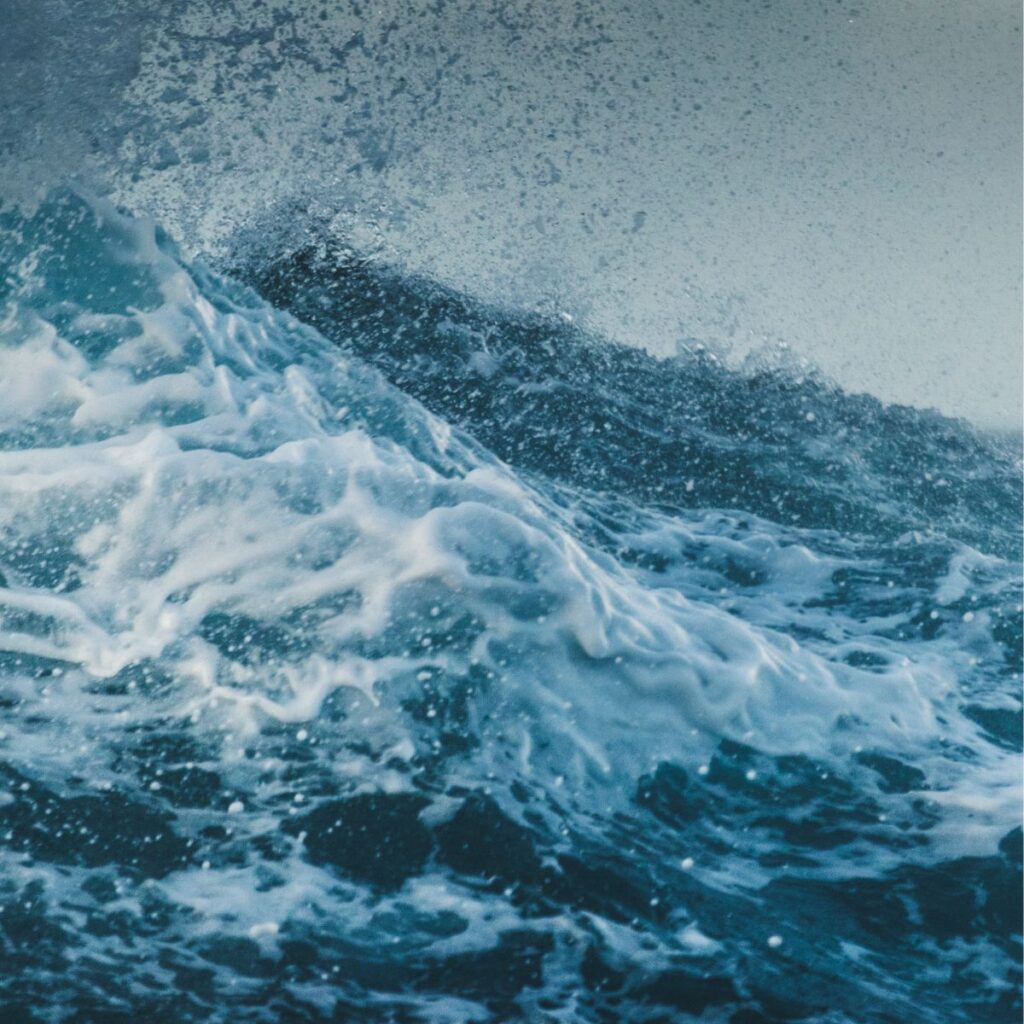
The Drake Passage
If you’re looking to cross off all seven continents, you’ll have to board an expedition ship to step foot on Antarctica, as mainstream cruise lines only traverse through the Drake Passage.
The Drake Passage is one of the roughest seas in the world, and it’s located between Cape Horn and the South Shetland Islands.
It’s the shortest crossing between Antarctica and the rest of the world, connecting the Atlantic and Pacific oceans.
The area has no large landmasses, so there is a large, unimpeded flow of current that carries a huge volume of water through the passage.
When these strong currents meet high wind speeds, the result is a sea state that is notoriously rough. This combination of factors contributes to conditions where it is quite likely for passengers to encounter rough seas in this area.
These challenging conditions are a defining characteristic of Cape Horn, making it one of the most hostile waters for sea travel.
The Bay of Biscay
If you plan to take a European cruise, you should approach the Bay of Biscay with caution.
The Bay of Biscay is located off the west coast of France and the north of Spain.
The Bay of Biscay is home to parts of the continental shelf that extend far into the bay, resulting in some shallow waters.
This is an area that experiences the fiercest Atlantic weather, and the combination of powerful winds and a shallow seabed can produce large waves.
Traveling during the summer months can significantly enhance your chances of encountering smoother seas.
On the other hand, opting for a late spring journey may bring you face-to-face with the unique “June Gloom” phenomenon. This is characterized by a vast fog triangle that often envelops the southern part of the bay.
This seasonal atmospheric condition, most prevalent in June, results in a dense fog that adds a mystical ambiance to the area, though it doesn’t typically affect sea conditions significantly.
Cruises that often sail through the Bay of Biscay include those sailing from Southampton to Portugal and Spain. Transatlantic voyages that begin in the UK and Northern Europe will often sail south and visit the Azores before beginning to cross the ocean, too.
When cruising through the Bay of Biscay, be prepared for rough seas and pack accordingly. It is recommended to bring motion sickness medication and warm clothing, as the weather can be unpredictable.
The Gulf of Alaska

If you’re heading on a cruise around Alaska, you will be pleased to hear that most of the cruise will be spent on the beautiful calm waters of the Inside Passage, where a string of islands will provide shelter and a high chance of smooth sailing.
But, if you are heading for ports at Seward, Whittier, or Anchorage, you will have to cross the Gulf of Alaska.
These waters are much rougher than the protected waters of the Inside Passage due to strong surface currents and cold air.
This is a much rougher area where strong surface currents and cold arctic air meet to generate powerful storms that affect British Columbia and the western U.S. Storms can happen at any time, but the worst time is between October and February.
Note: the vast majority of Alaska cruises take place within the sheltered waters of the Inside Passage. If you want to avoid cruising through the Gulf of Alaska, consider a round-trip cruise from Seattle.
However, cruises that do traverse through the Gulf of Alaska tend to visit more remote parts of Alaska, providing a unique and adventurous experience.
The Atlantic Ocean
Whenever you cross a large body of water, you’re more likely to encounter some rough waves since there’s no land nearby to provide any protection.
The Atlantic Ocean is no exception. Transatlantic cruises tend to see their roughest waters in November, December, and February.
If you’re going to embark on a transatlantic cruise in the winter, it’ll most likely be on either a luxury cruise line like Oceania or Cunard from New York to Southampton and vice versa.
While the winter months are the most intense, it’s important to note that other times of the year can also be impacted, particularly during hurricane season.
It’s always a good idea to keep an eye on the weather forecast and prepare accordingly.
If you’re concerned about rough waters, it’s best to stick to more protected areas of the Atlantic, such as the Caribbean or Mediterranean, where the waters are generally calmer.
The Mediterranean
If you’re looking to stay in the Mediterranean and visit culturally rich ports of call like Barcelona, Rome, Naples, then you’re in luck.
While the sea itself is relatively sheltered, It can be surprisingly rough, subject to rough waters in the fall and winter, as this is when the winds are the strongest.
Rough seas can happen at any time, though, and spring and summer cruise passengers might experience some rough seas.
Cruises in the Western Mediterranean, often embarking from ports like Barcelona or Rome, might encounter a unique weather phenomenon known as a “medicane.” This term, a blend of “Mediterranean” and “hurricane,” describes a rare but intense storm that shares characteristics with hurricanes and can impact this region.
These medicanes, though not as common as typical hurricanes, can still significantly influence sea conditions and cruise experiences in the Western Mediterranean.
This is a tropical storm that usually hits the region about once a year, most commonly in the autumn.
The Caribbean

The allure of the Caribbean as a cruising hotspot is undeniable, with its stunning beaches, crystal-clear waters, and inviting tropical cocktails. It’s a destination that appeals all year round, offering a blend of relaxation and scenic beauty.
Yet, it’s important to note that the region does experience its share of stormy weather, particularly during the hurricane season, which spans from June to November.
The likelihood of encountering hurricanes and tropical storms is highest from August to September.
If the idea of navigating through larger waves or facing potential changes in your cruise itinerary is less appealing, it might be wise to plan your trip outside these months.
Additionally, in the Caribbean, where different bodies of water converge, such as the meeting point of the Caribbean Sea and the Atlantic Ocean, there’s an increased likelihood of encountering rough seas, especially during the storm-prone months.
The South China Sea
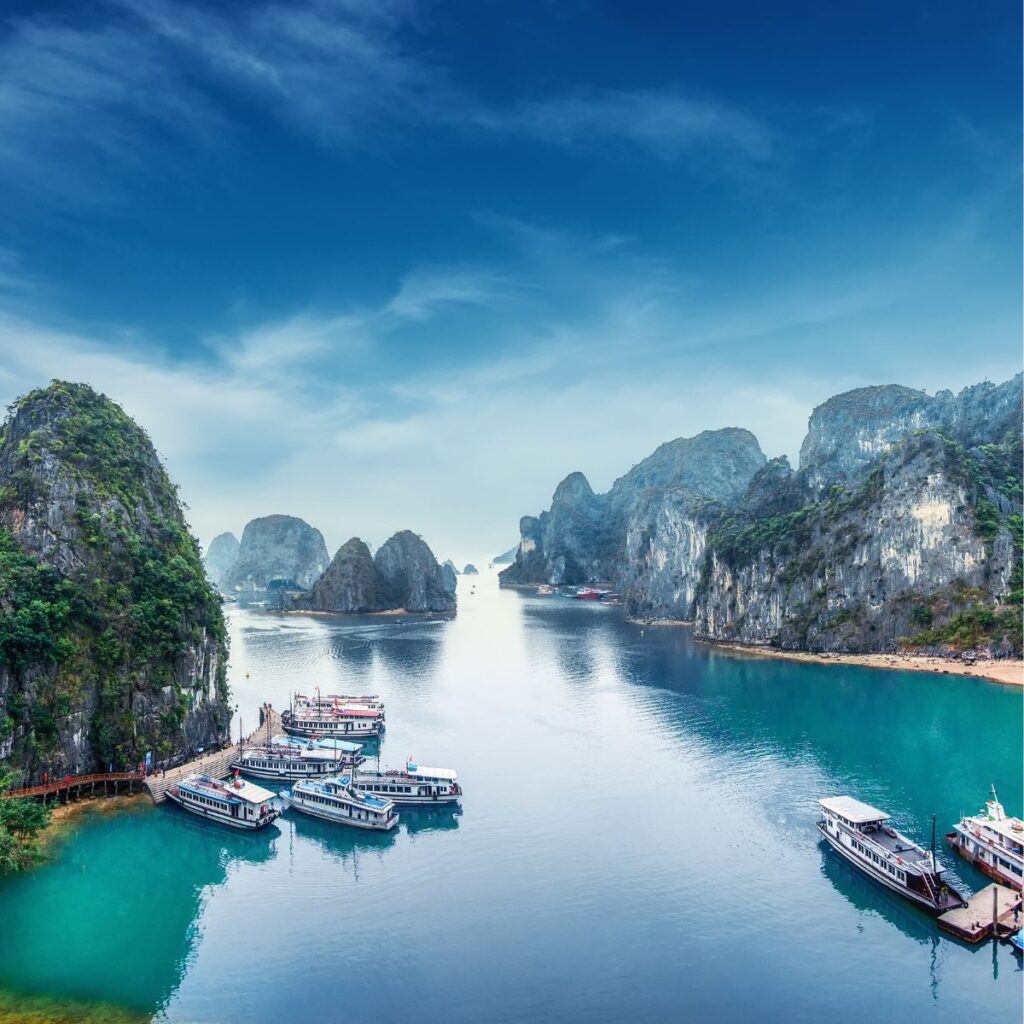
If you’re planning on taking an Asian cruise, you may be curious about the South China Sea.
This region is becoming increasingly popular for mainstream cruise lines, with Disney Cruise Line and Royal Caribbean both increasing their presence in Asia.
This area, part of the northwest Pacific Ocean, is known for its susceptibility to storms throughout the year, potentially leading to rough sea conditions.
Tropical typhoons and cyclones, most prevalent during the tropical storm season from July to November, are the primary causes of the biggest waves in this region. Storm activity tends to peak around late August and early September.
Key departure ports for cruises traversing this area include Singapore, along with other popular ports like Hong Kong, Shanghai, Beijing, and Bangkok. Routes connecting China to destinations such as Vietnam, Cambodia, or the Philippines are particularly prone to typhoons, which can result in a turbulent journey and possible changes to port stops.
On top of this, the South China Sea encompasses a region known as “The Dangerous Ground.” This area is infamous for its hidden dangers, including low-lying islands and submerged reefs that can emerge unexpectedly from the depths.
Due to its complex geography and historical territorial disputes, this zone is typically avoided in Asian cruise itineraries, regardless of the starting port. This precaution is taken to ensure a safer and smoother cruising experience in the often unpredictable waters of the South China Sea.
The North Sea
If you’re planning a cruise to North Europe, the British Isles, or even Iceland, you’ll likely have to pass through the North Sea.
Sailing through the North Sea can be quite challenging due to its susceptibility to high winds and waves, which often result in rough waters and thick fogs.
Traveling through the North Sea, especially from ports like Southampton to destinations such as Edinburgh, cruisers may encounter rough conditions.
The waters here can get particularly choppy, causing ships to experience significant rocking, akin to the sensations of a roller coaster.
While modern cruise ships are designed to handle these rough seas, passengers should be prepared for potential changes in their itineraries.
What Is Considered Rough Seas For A Cruise Ship?
Rough seas for a cruise ship are typically characterized by high winds and significant wave heights, which can lead to noticeable ship movement and discomfort for passengers.
Generally, waves exceeding 7-8 feet (about 2-2.5 meters) are considered rough, but modern cruise ships are designed to handle much higher waves safely.
The Beaufort Wind Scale, which categorizes wind speed, is often used to gauge sea conditions; rough seas are usually indicated by wind speeds over 17 knots (about 20 mph or 31 km/h).
These conditions can cause a cruise ship to pitch (move up and down) or roll (tilt side to side), leading to a more turbulent experience on board.
The perception of roughness can can vary among passengers, depending on their susceptibility to seasickness and the design and size of the ship. Larger, more modern cruise ships are equipped with stabilizers that significantly reduce the rolling motion, making them more resilient to rough seas.
Despite this, in extremely high seas with waves reaching over 15 feet (4.5 meters) or in the case of severe storms, even large ships might experience noticeable movement.
Cruise lines closely monitor weather conditions and may alter itineraries to avoid rough seas for passenger comfort and safety.
What Time Of Year Are Seas The Roughest?
The roughest seas typically occur during the transition between seasons, particularly in regions prone to cyclones or hurricanes.
In the Atlantic and Caribbean, for instance, the hurricane season peaks from August to October, bringing turbulent seas with higher risks of storms and rough conditions.
Similarly, in the Pacific, typhoon season, which typically lasts from May to October, can lead to rough seas, especially around Southeast Asia and the Western Pacific.
In contrast, the Southern Hemisphere experiences its roughest seas during its winter months, from June to August. This is especially true in areas like the Southern Ocean, where cruises to destinations like Antarctica are affected.
The Drake Passage, known for some of the world’s most challenging sailing conditions, sees its roughest waters during this period.
On top of this, areas like the North Sea and the Mediterranean can also experience rougher conditions during the winter months.
Are Cruise Ships Safe in Rough Seas?

Yes, cruise ships are safe in rough seas. They are designed to withstand waves up to 15 feet high, and they have stabilizers to reduce the amount of rocking felt onboard. However, you may still feel the motion of the waves, especially if they are particularly large.
If the captain deems it necessary, they may order passengers to stay indoors. It is also a good idea to stay seated and take medication for motion sickness if necessary.
In extreme weather conditions, such as encountering 30-foot waves, cruise ships like the Anthem of the Seas have successfully navigated through with no major issues or injuries to passengers or crew.
Are Seas Rough in the Caribbean?
The Caribbean, renowned for its typically calm cruising conditions, does encounter rougher seas under certain circumstances.
The Atlantic hurricane season, spanning from June to November, presents the highest likelihood of experiencing turbulent waters in the Caribbean, particularly in zones where the Caribbean Sea converges with the Atlantic Ocean.
Despite these seasonal challenges, major cruise lines continue to operate numerous voyages to the Caribbean throughout the hurricane season.
They often modify their sailing routes to circumvent the most severe storms, which means that cruise itineraries may be more prone to alterations during these months.
Are Seas Rough On A Transatlantic Cruise?
Seas on a transatlantic cruise can indeed be rough at times, primarily due to the vast and open nature of the Atlantic Ocean. The experience of rough seas on such a cruise largely depends on the time of year and the specific route taken.
For example, during the Atlantic hurricane season, which runs from June to November, there’s a higher chance of encountering rougher seas, particularly in the North Atlantic. This is due to the increased likelihood of storms and turbulent weather patterns.
Are Seas Rough Around Japan?
The seas around Japan can be rough at certain times of the year, influenced by the region’s specific climatic conditions. The most significant factor is the typhoon season, which typically runs from May to October.
During this period, the waters around Japan can become particularly turbulent due to the increased likelihood of typhoons and storms.
These weather events can lead to high waves and strong winds, creating challenging conditions for sea travel.
Are The Seas Rough Around Cape Horn?
The seas around Cape Horn, located at the southern tip of South America, are notorious for being some of the roughest in the world.
This reputation is largely due to the confluence of the Atlantic and Pacific Oceans in this region, combined with strong winds, large waves, and unpredictable weather patterns.
The area is known for its challenging sailing conditions, characterized by what sailors call the “Roaring Forties” and “Furious Fifties” — strong westerly winds found in the Southern Hemisphere, particularly between the latitudes of 40 and 50 degrees.
Similar Posts

19 Cruise Packing Mistakes Everyone Makes (And How To Avoid Them)

Carnival Cruise Card Colors Guide (Tiers and Perks EXPLAINED!)

14 Smallest Cruise Ships in The World You Have To Sea (lol)
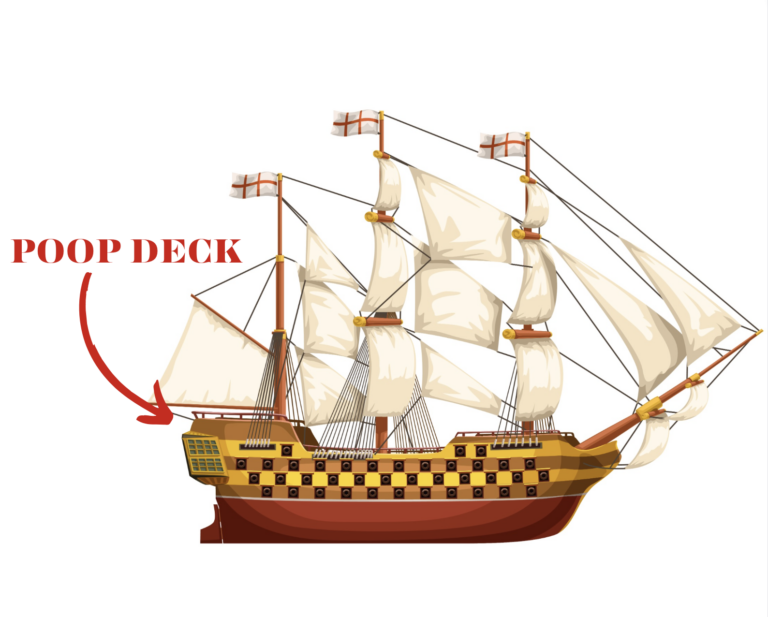
Poop Deck Meaning: WTF Are They?!

29 Cruise Cabin Hacks Every Traveler MUST-KNOW

How To Get Away With Smoking On A Cruise Ship: What Smokers NEED To Know
Leave a reply cancel reply.
Your email address will not be published. Required fields are marked *
Save my name, email, and website in this browser for the next time I comment.
MEGA YACHT, SUPER YACHT OR GIGA YACHT? WHAT TO CALL THE WORLD'S LARGEST YACHTS
There is no looking away when a large luxury yacht sails into view. the biggest super yachts in the world will always mesmerize and intrigue us, whether we are gazing at them from land or sea. but what to call these most expensive super yachts in the world there are no solid definitions when it comes to deciding if a boat is a super yacht, a mega yacht, or a giga yacht. or is that big boat just a yacht there is some general consensus on terminology, however, and several factors come into play when attempting to define the largest yachts in the world:.

IN THE TIME BEFORE SUPER YACHTS
Maritime history places private yachting in existence as early as the 1600s. At that time, boats began to be used occasionally as recreational vessels, rather than just as work boats. Later, private citizens, not just royalty, eventually began to own their own boats. These were separated from functional craft and the word "yacht" came into play.
LENGTHS OF A SUPER YACHT, MEGA YACHT, AND GIGA YACHT
A boom in large yacht construction blossomed around the time of the Industrial Revolution in the United States. As this era of wealth grew for family names such as Carnegie, Rockefeller, Morgan, and Vanderbilt, so did interest in the luxuriousness of these yachts, which they often saw as an extension of their family mansions. Since these boat owners were seldom mariners themselves, they hired crew to help run these vessels. The largest of these large boats of the time were considered yachts.

The length overall of a boat - for both powerboats and sailboats - is the first clue to how it is named in the yacht-industry nomenclature. Many maritime businesses will use the term super yacht for vessels at least 80 feet (24 meters) in length, while some consider super yachts to be a minimum of 100 feet in length (30 meters).
Many people use the terms super yacht and mega yacht interchangeably, while others believe a mega yacht starts at 200 feet (60 meters). There is also some consensus that an extremely high level of service from the onboard crew can bump a superyacht into the megayacht realm.
But as the largest of the yachts continue to grow in length, even the term mega yacht seems insufficient. Faster than the largest yacht in the world can be crowned, plans are already drawn up to exceed its length.
Should the largest, nearly 600-foot-long yacht fall into the same naming category as the 200-foot yacht? Probably not. For this reason, many more in the maritime industry will put the largest of the large luxury yachts into the giga yacht group. Similarly, the immense vessels that are still in the idea/discussion phase are called giga yacht concepts.
MEGA YACHT REGIONS
There are informal regional trends when it comes to naming the largest of the super-, mega-, and giga yachts. Although English is the primary language in much of North America and Europe, English can seem like two different languages when comparing London with New York. This is also true with yacht terminology.
Often the European yachting industry uses the term superyacht (or super yacht) while the United States more frequently uses the term megayacht (or mega yacht). As the yacht industry continues to grow, the use of super to describe a large, luxury yacht seems to be more predominant worldwide.

SUPER YACHT LEGALESE
Another factor that helps define boats is the legal aspect as described by several maritime groups. Whether the boat in question is the smallest rowboat, dinghy, or tender, or the biggest boat in the world, international and local regulations hold a few clues.
One international governing body is the Maritime and Coastguard Agency (MCA) based in the United Kingdom. This British agency legislates and guides the maritime industry with national and international support and has been a leader in internationally recognized definitions.
According to the MCA's Large Commercial Yacht Code's definition, "Large means 24 meters and over in load line length and the Code of Practice applies to yachts which are in commercial use for sport or pleasure, do not carry cargo, and do not carry more than 12 passengers."
MEGA YACHT CREW
The presence of hired crew onboard definitely lends itself to referring to a boat as a yacht. As soon as captain, engineer, purser, deckhand, bosun, stewardess, stew, and chef are in uniform and on duty to serve the owner, the tendency is to use the term yacht in any form, whether a super yacht, a mega yacht, or a giga yacht.
So, with no "official" rules in play, you can use your own judgement and preference when calling a vessel, a boat, a yacht, a super yacht, a mega yacht, or a giga yacht.
SIGN UP FOR EMAIL UPDATES

COMMENTS
The Douglas Sea Scale defines 'rough seas' as 2.5-4m/4.1-8.2ft with very rough conditions being 4-6m/13-20ft. At Southampton University tank tests showed that when a wave was 30% as high as the hull length, it was possible to capsize some yachts. However a wave as high as 60% of the hull length capsized all vessels.
Subscribe before you goOn the Mighty Saint-Lawrence, just off shore from Sainte-Anne-Des-Monts Quebec, a luxury yacht makes way in rough seas, plunging and r...
The $350 million vessel has seven decks, a pool, and a yoga studio it uses AI to stabilize the mammoth yacht on rough seas. by Neha Tandon Sharma. Image credit - Tom van Oossanen. Aptly named Infinity, this imposing creation of Oceanco made history as soon as it hit the high seas. The interminable 384 footer is the largest motoryacht from ...
Being in a yacht while the sea is rough can be a challenging experience, both physically and mentally. In fact, the motion of a yacht in rough seas can trigger the symptoms of seasickness, which include nausea, dizziness, and fatigue. The feeling of being tossed around by the waves can also be anxiety-inducing, causing a sense of vulnerability ...
I was talking with Nordhavn's vice president Jim Leishman at the time, about the delivery of the company's new 414-ton 120-footer across the Pacific Ocean last summer from China, through the Bering Sea and the Aleutians, across the Gulf of Alaska, and down the Inside Passage to Vancouver, British Columbia. Leishman, his brother Jeff, and a ...
4. 'Galeocerdo' | 74.8 mph. Wally founder Luca Bassani designed the 118-foot Galeocerdo to maintain speed in rough seas. Launched in 2003 by Rodriquez Yachts, the boat racks up an eye-watering ...
Weiss, who helped pen the design of such landmark superyachts as Galactica Star, the 213-foot all-aluminum Heesen, along with the 239-foot CRN-built Yalla, quickly adds that the yacht isn't just ...
Definitely not a good day for a cocktail cruise around the bay. This was the punishing sea-trial inflicted on the newly christened Enmer, a no-nonsense 75-foot XSV20 explorer yacht, before being ...
Designs such as the wave-piercing hull and the axe-bow hull improve stability, speed, and fuel efficiency. These advancements allow mega-yachts to travel faster and more smoothly, even in rough seas. The focus on innovative hull designs reflects the industry's commitment to enhancing both the performance and the visual appeal of mega-yachts. 5.
The Lightning yacht is but one jewel in the crown of this shipyard's prestigious legacy, a legacy that continues to redefine elegance and sophistication on the high seas. Unveiling the Lightning Superyacht. Prepare to be awe-struck as we stand before the Lightning, a colossal mega yacht that stretches an astonishing 140 meters in length.
Today's technology has pushed sport-fishing boats to mega-yacht lengths and beyond. By Chris Caswell Updated: January 12, 2021 The Viking Yachts 92 comes in open-bridge, enclosed-bridge and sky-bridge configurations. ... Keep in mind, however, that a 300-gross-ton 144-footer traveling at 33 knots can maintain that speed in rough seas while ...
Yep. To me "mega" starts at around 150 feet. but I think that the ability to land a helicopter on it would definitely make it mega. Also, the ability to launch a runabout (vs a dinghy) from a waterline dock would certainly place the boat in megayacht territory.
Yes, mega yachts and superyachts can cross the Atlantic or the Pacific Ocean. We know it would take a superyacht around 10 days to cross, but the Pacific Ocean is a larger body of water for superyachts to cross but it is possible to do so. When yachts are traveling from the US to areas such as Fiji or the Islands of Tahiti, the boats will sail ...
One of the most memorable launches of 2021, the 139.7 metre super explorer yacht Solaris travelled to the top of this coveted list of expedition yachts when she hit the water last year. The highly secretive project is built by Lloyd Werft, which also delivered the 115m explorer Luna in 2010, the fourth largest explorer yacht in the world. Spread across an impressive eight decks, Solaris was ...
The mega yacht can accommodate as many as 64 guests and is manned by a crew of 65. Builder: Helsingor Vaerft; Country of build: Denmark; Delivery year: 1984; Length Overall: 147 m; Beam: 18.3 m; ... PYC-compliant Flying Fox was built by Lürssen for a serial charter yacht owner and completed her sea trials off the coast of Germany in May 2019 ...
Here you will find a variety of videos showing the coolest boats hitting rough waves through the infamous Haulover Inlet, one of the most dangerous inlets in...
The Seven Seas yacht, valued at $250 million, was built in 2022 by the renowned Dutch yacht builder, Oceanco. It is powered by top-of-the-line MTU engines and can reach a maximum speed of 20 knots. The vessel, designed by SINOT Yacht Design, can accommodate 14 guests in 7 suites with a dedicated crew of 30. Steven Spielberg is the proud owner ...
Rescue personnel lifting a body bag after a luxury yacht carrying the British entrepreneur Mike Lynch and others sank off the coast of Porticello, Italy, on Wednesday. Guglielmo Mangiapane/Reuters ...
Best Multipurpose Stern: Bering B165. Turkish boatbuilder Bering Yachts revealed details of its new 162-foot flagship explorer yacht, the B165, at the Dubai International Boat Show in March. The ...
The pitch and yaw of rough seas and gusty winds can turn a dutch oven into a scud missile. Things like glass jars and wine glasses soon become shrapnel as objects fling themself out of cupboards and smash on bulkheads and cabin floors. When I was buying my endeavour 42, I hired a delivery captain to fit out the boat and sail it from Tampa Bay ...
MEGA YACHT VS ROUGH WAVES AT HAULOVER INLET!! [Boats at Haulover Inlet]These Mega Yachts of Haulover inlet are incredible....
The Drake Passage is one of the roughest seas in the world, and it's located between Cape Horn and the South Shetland Islands. It's the shortest crossing between Antarctica and the rest of the world, connecting the Atlantic and Pacific oceans. The area has no large landmasses, so there is a large, unimpeded flow of current that carries a ...
Many people use the terms super yacht and mega yacht interchangeably, while others believe a mega yacht starts at 200 feet (60 meters). There is also some consensus that an extremely high level of service from the onboard crew can bump a superyacht into the megayacht realm. But as the largest of the yachts continue to grow in length, even the ...